#dr. hans keller
Explore tagged Tumblr posts
Text


"On May 14, 1967, Syd Barrett and Roger Waters were interviewed by musicologist Dr. Hans Keller on the BBC program 'Look Of The Week.' The reviewer noted that Pink Floyd's music was "terribly loud" and "a throwback to childhood." On that same show they performed, 'Pow R. Toc H.' and 'Astronomy Dominé.'"
youtube
#syd barrett#pink floyd#roger waters#1967#dr. hans keller#interview#progressive rock#60s music#annoying interviewer#Youtube
41 notes
·
View notes
Text






























Wagner - - October 3, 1983 - December 11, 1983
Drama / Biography (10 episodes)
Running Time: 466 minutes total
Stars:
Richard Burton as Richard Wagner
Gemma Craven as Minna Planer, later Wagner
Dame Vanessa Redgrave as Cosima von Bülow, later Wagner
Miguel Herz-Kestranek as Hans von Bülow
László Gálffi as King Ludwig II of Bavaria
Zoltán Gera as Lüttichau
Sir John Gielgud as Franz Seraph von Pfistermeister
Sir Laurence Olivier as Sigmund von Pfeufer [de]
Sir Ralph Richardson as Baron Karl Ludwig von der Pfordten
Ekkehard Schall as Franz Liszt
Ronald Pickup as Friedrich Nietzsche
Liza Goddard as Jessie Laussot
Marthe Keller as Mathilde Wesendonck
Richard Pasco as Otto Wesendonck [de]
Peter Hofmann as Ludwig Schnorr von Carolsfeld
Dame Gwyneth Jones as Malvina Schnorr von Carolsfeld
Jess Thomas as Albert Niemann
Vernon Dobtcheff as Giacomo Meyerbeer
Gabriel Byrne as Karl Ritter
Sir William Walton as King Frederick Augustus II of Saxony
Lady Susan Walton as Maria Anna of Bavaria, wife of Frederick
Sigfrit Steiner as King Ludwig I of Bavaria
Barbara Leigh-Hunt as Queen Marie of Bavaria Marie of Prussia
Daphne Wagner [de] as Princess Pauline von Metternich
Dame Joan Plowright as Mrs Taylor
Corin Redgrave as Dr Pusinelli
Prunella Scales as Frau Pollert
Andrew Cruickshank as the Narrator
#Wagner#TV#Historical Drama#1983#Richard Burton#Vanessa Redgrave#Gemma Craven#Sir John Gielgud#Sir Laurence Olivier#Ralph Richardson
2 notes
·
View notes
Text
List of Fandoms/Characters I write for...

House of the Dragon ❀Criston Cole ❀Aemond Targaryen ❀Aegon II Targaryen ❀Harwin Strong ❀Cregan Stark ❀Gwayne Hightower ❀Cregan Stark
Game of Thrones ❀Sandor Clegane ❀Tormund Giantsbane ❀Podrick Payne ❀Jon Snow ❀Robb Stark ❀Theon Grejoy ❀Jorah Mormont ❀Samwell Tarly ❀Gendry Waters ❀Tyrion Lannister ❀Jaime Lannister ❀Oberyn Martell ❀Ramsay Bolton ❀Viserys Targaryen ❀Khal Drago ❀Daario Naharis ❀Dickon Tarly ❀Koner ❀Ser Davos Seaworth
The Walking Dead ❀Rick Grimes ❀Shane Walsh ❀Merle Dixon ❀Daryl Dixon ❀Glenn Rhee ❀Jerry ❀Negan ❀Milton Mamet ❀Ceasar Martinez ❀Siddiq ❀Abraham Ford ❀Eugene Porter ❀Noah ❀Theodore "T-Dog" Douglas ❀Beta ❀Alden ❀Simon ❀Benjamin ❀Phillip "The Governor' Blake ❀Dante ❀Dwight
Fear the Walking Dead ❀Troy Otto ❀Jake Otto ❀John Dorie ❀Nick Clark ❀Morgan Jones
Mayans MC ❀Ezekiel Reyes ❀Angel Reyes ❀Neron "Creeper" Vargas ❀Johnny "Coco" Cruz ❀Nestor Oceteva ❀Hank Loza ❀Gilberto "Gilly" Lopez ❀Bishop Losa ❀Che "Taza" Romero ❀Miguel Galindo
Sons of Anarchy ❀Jax Teller ❀Harry "Opie" Winston ❀Juan "Juice" Ortiz ❀Alexander "Tig" Tragger ❀David Hale ❀Chibs Telford ❀Bobby Muson ❀Happy Lowman ❀Herman Kozik
Marvel ❀Steve Rogers ❀Bucky Barnes ❀Sam Wilson ❀Joaquin Torres ❀Baron Helmut Zemo ❀Tony Stark ❀Bruce Banner ❀Clint Barton ❀Thor ❀Loki ❀Pietro Maximoff ❀James "Rhodey" Rhodes ❀John Walker ❀Eddie Brock ❀Erik Killmonger ❀Charlies Xavier ❀Druig ❀Ikaris ❀Hank Mccoy ❀Frank Castle ❀Billy Russo ❀Danny Rand ❀Matthew Murdock ❀Kraven the Hunter ❀Dane Whitman ❀Wade Wilson ❀Pior "Colussus" Rasputin ❀Johnny Storm
DC ❀Adrian Chase ❀Clark Kent ❀Arthur Curry ❀Hank Hall ❀Leonard Snart ❀The Joker (Heath Ledger) ❀Victor Zsasz (Gotham) ❀Oswald Cobblepot (Gotham) ❀Edward Nygma (Gotham) ❀Butch Gilzean ❀Harvey Bullock ❀Christopher "Peacemaker" Smith ❀Jerome Valeska ❀Mick Rory ❀George "Digger"Harkness ❀Ciso Ramon ❀Ray Palmer ❀Bruce Wayne (Christian Bale) ❀Chato Santanna ❀Rick Flag ❀Alfred Pennyworth
The Batman 2022 (Matt Reeves) ❀Oswald Cobb ❀Salvatore Maroni
Stranger things ❀Eddie Munson ❀Steve Harrington ❀Jim Hopper ❀Jonathan Buyers ❀Dr Alexie
Vikings ❀Ivar the boneless ❀Rollo ❀Ragnar Lothbrok ❀Ubbe ❀Sigurd ❀Hvitserk ❀Bjorn Ironside ❀Halfdan the black ❀Harald Finehair ❀Aethelred ❀Aethelstan ❀Alfred
Bridgerton ❀Prince Fredrich ❀Anthony Bridgerton ❀Benedict Bridgerton ❀Colin Bridgerton
The Witcher ❀Jaskier ❀Eskel ❀Geralt of Rivia ❀Lambert
Top Gun ❀Robert "Bob" Floyd ❀Jake "Hangman" Seresin ❀Bradley "Rooster" Bradshaw ❀Pete "Maverick" Mitchell
Shadow Hunters ❀Raphael Santiago ❀Simon Lewis ❀Jace Herondale ❀Alec Lightwood
Fast and Furious ❀Deckard Shaw ❀Han Lue ❀Jakob Toretto ❀Dante Reyes ❀Aimes ❀Owen Shaw
Zoo ❀Mitch Morgan ❀Jackon Oz
Twilight ❀Carlise Cullen ❀Charlie Swan ❀Sam Uley ❀Garrett ❀Emmett Cullen
Ewan Mitchell Characters ❀Tom Bennett ❀Micheal Gavey ❀Billy Washington
Joseph Quinn Characters ❀Tom Grant ❀Billy Knight ❀Eric (A quiet Place) ❀Emperor Greta
Henry Cavil Characters ❀Napleon Solo ❀Captain Syverson ❀Charles Brandon ❀Walter Marshall ❀Gus March Phillips ❀Sherlock Holmes
Chris Evans Characters ❀Ari Levinson ❀Hugh Ransom Drysdale ❀Loyd Hansen ❀Andy Barber
Primeval ❀Connor Temple
Law and Order - SVU ❀Rafael Barba ❀Sonny Carisi
Criminal Minds ❀Spencer Reid ❀Derek Morgan ❀Luke Alverez ❀Aaron Hotchner
9-1-1 ❀Evan "Buck" Buckley ❀Eddie Diaz ❀Albert Han ❀Howard "Chimney" Han
Station 19 ❀Dean Miller ❀Jack Gibson
Chicago PD ❀Kevin Atwater
Chicago Fire ❀Kelly Severide ❀Matt Casey ❀Brian "Otis" Zvoneck
Call of Duty ❀Simon "Ghost" Riley ❀Captain John Price ❀Alex Keller ❀John "Soap" McTavish ❀Koing ❀Phillip Graves ❀Nikolai ❀Kyle "Gaz Garrick ❀Alejandro Vargas ❀Rudolfo "Rudy" Parra ❀Vladimir Makarov ❀Frank Woods ❀Alex Mason ❀Lucas Riggs ❀Wade Jackson
Grimm ❀Nick Burkhadt ❀Monroe ❀Captain Sean Renard
Beauty and the Beast ❀The Beast ❀Gaston
Shameless ❀Lip Gallagher ❀Kevin Ball
Black Sails ❀Long John Silver ❀Charles Vane ❀Jack Rackham ❀Captain James flint
The Night Agent ❀Peter Sutherland
Harry Potter; ❀Remus Lupin ❀Sirius Black ❀James Potter ❀Oliver Wood ❀Percy Weasley ❀Charlie Weasley ❀Fred Weasley ❀George Weasley ❀Bill Weasley ❀Viktor Krum ❀Neville Longbottom ❀Cedric Diggory ❀Severus Snape ❀Cormac Mclaggen
Fantastic Beasts and where to find them ❀Thesus Scamander ❀Newt Scamander
Vampire Diaries ❀Damon Salvatore ❀Stefan Salvatore ❀Enzo St John
The Originals ❀Niklaus Mikealson ❀Elijah Mikealson ❀Kol Mikealson
Maze Runner ❀Gally
Greys Anatomy ❀George O'Malley
The Mummy ❀Rick O'Connell ❀Ardeth Bay
Once Upon a time ❀Killian Jones ❀David Nolan ❀August Wayne Booth ❀Neal "Bealfire" Cassidy ❀Rumplestiltskin ❀Sheriff Graham Humbert ❀Jefferson
The Musketeers (BBC) ❀Porthos ❀Aramis ❀Athos ❀D'Artagnan
The Last Of Us ❀ Tommy Miller ❀Joel Miller
Fargo ❀Gator Tillman
Sebastian Stan Characters ❀Nick Fowler ❀Lee Bodecker ❀Mickey
Lewis Pullman Characters ❀Rhett Abbott
American Gods ❀Mad Sweeney
Scream ❀Dewey Riley ❀Billy Loomis ❀Stu Matcher
Shadow and Bone ❀Matthias Helvar ❀Kaz Brekker ❀Jesper Fahey ❀Nikolai Lantsov
Reacher ❀Jack Reacher
Bullet Train ❀Tangerine
Percy Jackson ❀Poseidon ❀Hepheastus ❀Aries ❀Hades
The Last Kingdom ❀Osferth ❀Finnan ❀Sihtric ❀Ulthred
Dexter ❀Dexter Morgan
The Hunger Games ❀Haymitch Abernathy ❀Finnick Odair
AEW ❀Maxwell Jacob Friendman ❀Wardlow ❀Eddie Kingston ❀Orange Cassidy ❀Chuck Taylor ❀Trent Berretta ❀Cash Wheeler ❀Luchasarus ❀Hook ❀Kenny Omega ❀Daniel Garcia ❀Will Osprey
WWE ❀Damien Priest ❀Grayson Waller ❀Sheamus ❀Otis
#Oasisfandomlist#house of the dragon#Game of thrones#The Walking Dead#fear the Walking Dead#Marvel#DC#Bridgerton#Call of duty#WWE#Aew#Grimm#Once upon a time#sons of anarchy#The last Kingdom#Zoo#Bullet Train#Beauty and the beast#Scream#Percy Jackson#Black Sails#The Musketeers
9 notes
·
View notes
Text
THE 236 GREATEST PERSONALITIES IN THE ENTIRE KNOWN HISTORY/COLLECTIVE CONSCIOUSNESS OF THIS WORLD! (@INDIES)
ie. THE 236 GREATEST PERSONALITIES IN WORLD HISTORY! (@INDIES)
Rajesh Khanna
Lionel Messi
Leonardo Da Vinci
Online Indie
Muhammad Ali
Joan of Arc
William Shakespeare
Vincent Van Gogh
J. K. Rowling
David Lean
Nadia Comaneci
Diego Maradona
Wolfgang Amadeus Mozart
Meena Kumari
Julius Caesar
Harrison Ford
Ludwig Van Beethoven
William W. Cargill
Fritz Hoffmann-La Roche
Samuel Curtis Johnson
Sam Walton
John D. Rockefeller
Andrew Carnegie
Roy Thomson
Tim Berners-Lee
Marie Curie
James J. Hill
Cornelius Vanderbilt
Roman Polanski
Samuel Slater
J. P. Morgan
Cary Grant
Dmitri Mendeleev
John Harvard
Alain Delon
Ramakrishna Paramhansa (Official God)
The Lumiere Brothers, Auguste & Louis
Carl Friedrich Benz
Michelangelo
Maharishi Mahesh Yogi
Ramana Maharishi
Mark Twain
Swami Sri Yukteswar Giri
Bruce Lee
Bhagwan Krishna (Official God)
Charlemagne
Rene Descartes
John F. Kennedy
Bhagwan Ganesha (Official God)
Walt Disney
Albert Einstein
Nikola Tesla
Alfred Hitchcock
Pythagoras
William Randolph Hearst
Cosimo de’ Medici
Johann Sebastian Bach
Alec Guinness
Nostradamus
Christopher Plummer
Archimedes
Jackie Chan
Guru Dutt
Amma Karunamayi/ Mata Parvati (Official God)
Peter Sellers
Gerard Depardieu
Joseph Safra
Robert Morris
Sean Connery
Petr Kellner
Aristotle Onassis
Usain Bolt
Jack Welch
Alfredo di Stefano
Elizabeth Taylor
Michael Jordan
Paul Muni
Steven Spielberg
Louis Pasteur
Ingrid Bergman
Norma Shearer
Dr. B. R. Ambedkar
Ayn Rand
Jesus Christ (Official God)
Luciano Pavarotti
Alain Resnais
Frank Sinatra
Allah (Official God)
Richard Nixon
Charlie Chaplin
Thomas Alva Edison
Alexander Graham Bell
Wright Brothers
Arjun (of Bhagwan Krishna’s Gita)
Jim Simons
George Lucas
Swami Sri Lahiri Mahasaya
Carl Lewis
Brett Favre
Helen Keller
Bernard Mannes Baruch
Buddha (Official God)
Hugh Grant
K. L. Saigal
Roger Federer
Rash Behari Bose
Tiger Woods
William Blake
Jesse Owens
Claude Miller
Bernardo Bertolucci
Subhash Chandra Bose
Satyajit Ray
Hippocrates
Chiang Kai-Shek
John Logie Baird
Geeta Dutt
Raphael (painter)
Bhagwan Shiva (Official God)
Radha (Ancient Krishna devotee)
George Orwell
Jorge Paulo Lemann
Catherine Deneuve
Pierre-Auguste Renoir
Bill Gates
Bhagwan Ram (Official God)
Michael Phelps
Michael Faraday
Audrey Hepburn
Dalai Lama
Grace Kelly
Mikhail Gorbachev
Vladimir Putin
Galileo Galilei
Gary Cooper
Roger Moore
John Huston
Blaise Pascal
Humphrey Bogart
Rudyard Kipling
Samuel Morse
Wayne Gretzky
Yogi Berra
Barry Levinson
Patrice Chereau (director)
Jerry Lewis
Louis Daguerre
James Watt
Henri Rousseau
Nikita Krushchev
Jack Dorsey
Dev Anand
Elia Kazan
Alexander Fleming
David Selznick
Frank Marshall
Viswanathan Anand
Major Dhyan Chand
Swami Vivekananda
Felix Rohatyn
Sam Spiegel
Anand Bakshi
Victor Hugo
Bhagwan Sri Sathya Sai Baba (Official God)
Steve Jobs
Srinivasa Ramanujam
Lord Hanuman
Stanley Kubrick
Giotto
Voltaire
Diego Velazquez
Ernest Hemingway
Francis Ford Coppola
Michael Douglas
Kirk Douglas
Mario Lemieux
Kishore Kumar
James Stewart
Douglas Fairbanks
Confucius
Babe Ruth
Raj Kapoor
Titian aka Tiziano Vecelli
El Greco
Francisco de Goya
Jim Carrey
Mohammad Rafi
Steffi Graf
Pele
Gustave Courbet
Rani Laxmibai of Jhansi
Milos Forman
Steve Wozniak
Georgia O’ Keeffe
Mala Sinha
Aryabhatta
Magic Johnson
Patanjali
Leo Tolstoy
Tansen
Henry Fonda
Albrecht Durer
Benazir Bhutto
Cal Ripken Jr
Samuel Goldwyn
Mumtaz (actress)
Panini
Nicolaus Copernicus
Pablo Picasso
George Clooney
Olivia de Havilland
Prem Chand
Imran Khan
Pete Sampras
Ratan Tata
Meerabai (16th c. Krishna devotee)
Queen Elizabeth II
Pope John Paul II
James Cameron
Jack Ma
Warren Buffett
Romy Schneider
C. V. Raman
Aung San Suu Kyi
Benjamin Netanyahu
Frank Capra
Michael Schumacher
Steve Forbes
Paramhansa Yogananda
Tom Hanks
Kamal Amrohi
Hans Holbein
Shammi Kapoor
Gerardus Mercator
Edith Piaf
Bhagwan Shirdi Sai Baba (Official God) .
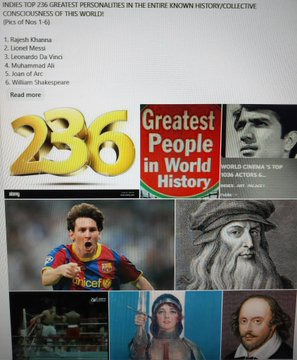
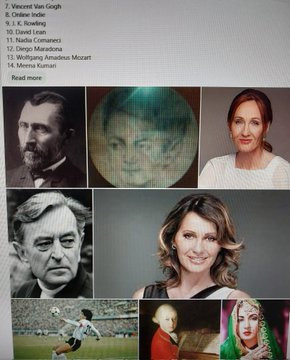
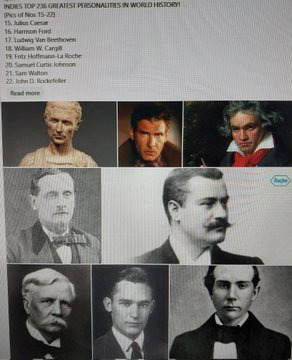
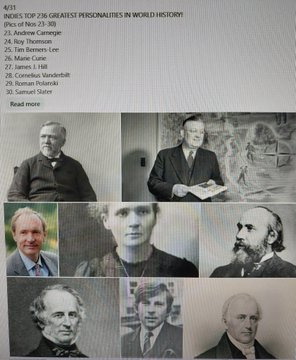
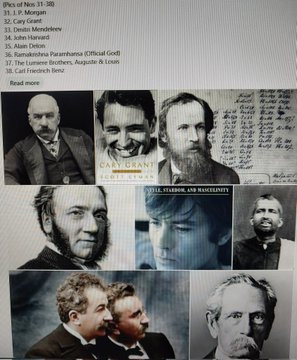

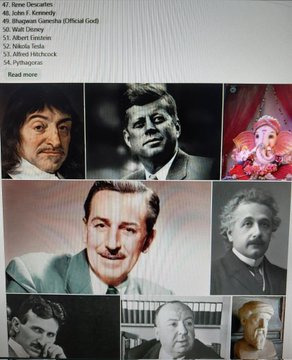
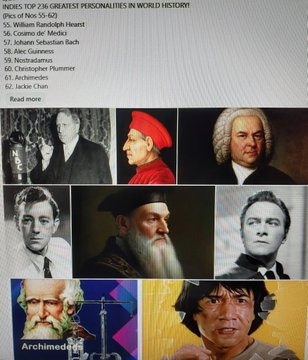
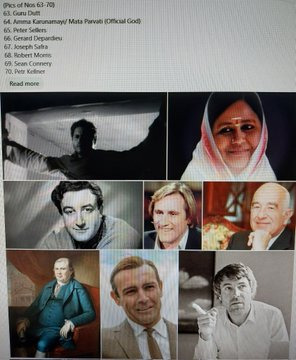
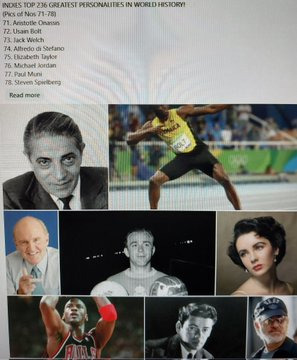
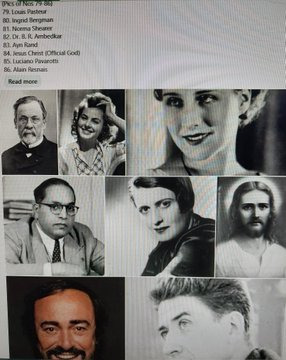
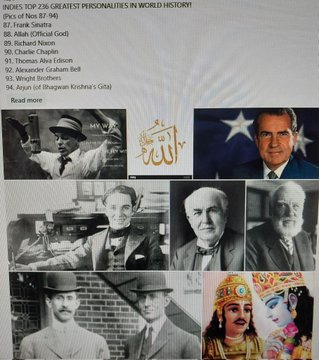
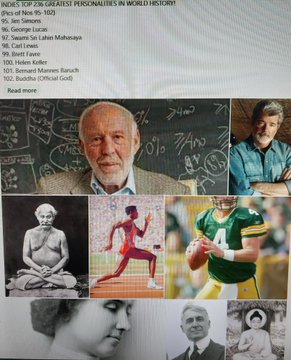
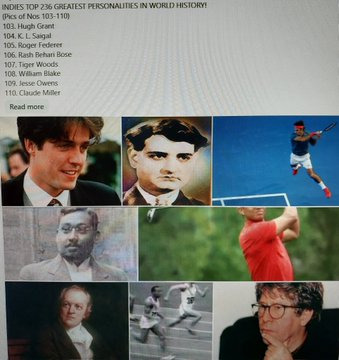
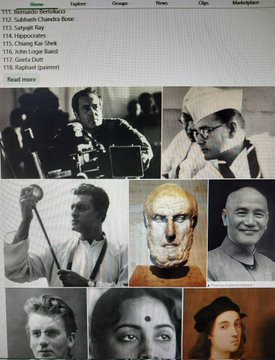
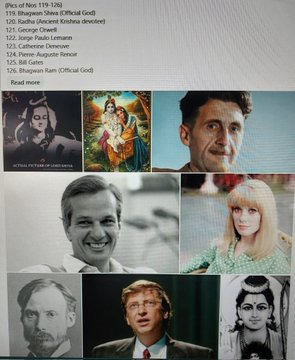
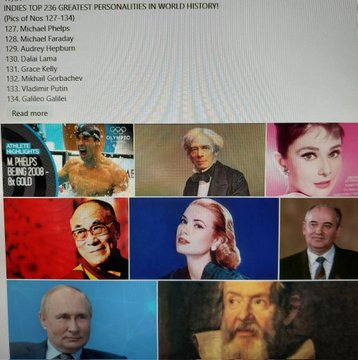
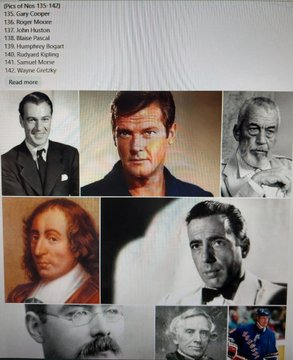

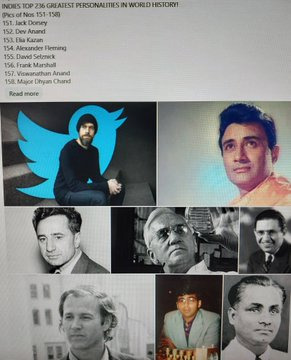
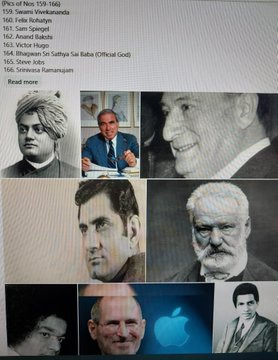
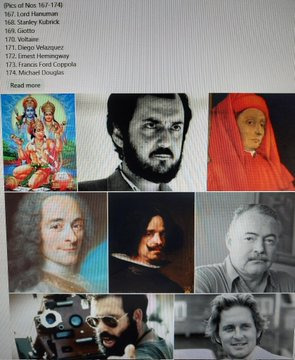
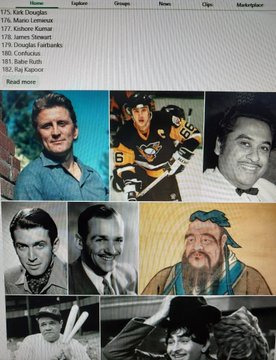
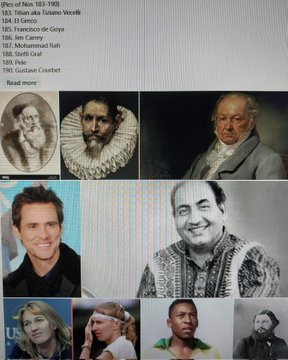
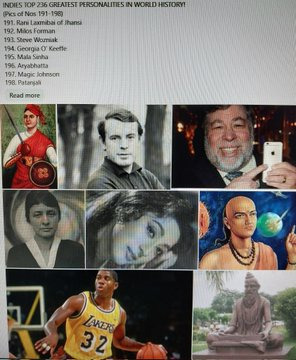
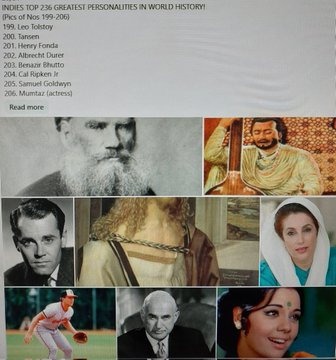
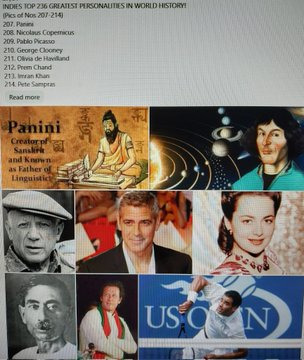
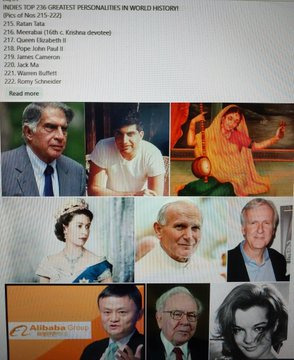
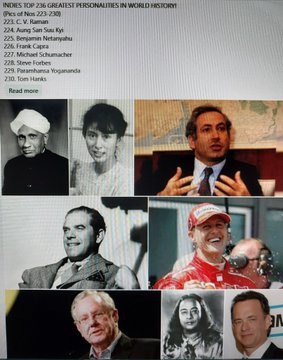
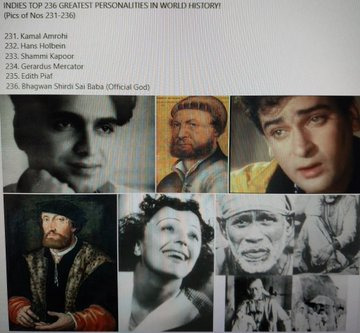
2 notes
·
View notes
Text
THE 236 GREATEST PERSONALITIES IN THE ENTIRE KNOWN HISTORY/COLLECTIVE CONSCIOUSNESS OF THIS WORLD! (@INDIES)
i.e. THE 236 GREATEST PERSONALITIES IN WORLD HISTORY! (@INDIES)
Rajesh Khanna
Lionel Messi
Leonardo Da Vinci
Muhammad Ali
Joan of Arc
William Shakespeare
Vincent Van Gogh
Online Indie
J. K. Rowling
David Lean
Nadia Comaneci
Diego Maradona
Wolfgang Amadeus Mozart
Meena Kumari
Julius Caesar
Harrison Ford
Ludwig Van Beethoven
William W. Cargill
Fritz Hoffmann-La Roche
Samuel Curtis Johnson
Sam Walton
John D. Rockefeller
Andrew Carnegie
Roy Thomson
Tim Berners-Lee
Marie Curie
James J. Hill
Cornelius Vanderbilt
Roman Polanski
Samuel Slater
J. P. Morgan
Cary Grant
Dmitri Mendeleev
John Harvard
Alain Delon
Ramakrishna Paramhansa (Official God)
The Lumiere Brothers, Auguste & Louis
Carl Friedrich Benz
Michelangelo
Maharishi Mahesh Yogi
Ramana Maharishi
Mark Twain
Swami Sri Yukteswar Giri
Bruce Lee
Bhagwan Krishna (Official God)
Charlemagne
Rene Descartes
John F. Kennedy
Bhagwan Ganesha (Official God)
Walt Disney
Albert Einstein
Nikola Tesla
Alfred Hitchcock
Pythagoras
William Randolph Hearst
Cosimo de’ Medici
Johann Sebastian Bach
Alec Guinness
Nostradamus
Christopher Plummer
Archimedes
Jackie Chan
Guru Dutt
Amma Karunamayi/ Mata Parvati (Official God)
Peter Sellers
Gerard Depardieu
Joseph Safra
Robert Morris
Sean Connery
Petr Kellner
Aristotle Onassis
Usain Bolt
Jack Welch
Alfredo di Stefano
Elizabeth Taylor
Michael Jordan
Paul Muni
Steven Spielberg
Louis Pasteur
Ingrid Bergman
Norma Shearer
Dr. B. R. Ambedkar
Ayn Rand
Jesus Christ (Official God)
Luciano Pavarotti
Alain Resnais
Frank Sinatra
Allah (Official God)
Richard Nixon
Charlie Chaplin
Thomas Alva Edison
Alexander Graham Bell
Wright Brothers
Arjun (of Bhagwan Krishna’s Gita)
Jim Simons
George Lucas
Swami Sri Lahiri Mahasaya
Carl Lewis
Brett Favre
Helen Keller
Bernard Mannes Baruch
Buddha (Official God)
Hugh Grant
K. L. Saigal
Roger Federer
Rash Behari Bose
Tiger Woods
William Blake
Jesse Owens
Claude Miller
Bernardo Bertolucci
Subhash Chandra Bose
Satyajit Ray
Hippocrates
Chiang Kai-Shek
John Logie Baird
Geeta Dutt
Raphael (painter)
Bhagwan Shiva (Official God)
Radha (Ancient Krishna devotee)
George Orwell
Jorge Paulo Lemann
Catherine Deneuve
Pierre-Auguste Renoir
Bill Gates
Bhagwan Ram (Official God)
Michael Phelps
Michael Faraday
Audrey Hepburn
Dalai Lama
Grace Kelly
Mikhail Gorbachev
Vladimir Putin
Galileo Galilei
Gary Cooper
Roger Moore
John Huston
Blaise Pascal
Humphrey Bogart
Rudyard Kipling
Samuel Morse
Wayne Gretzky
Yogi Berra
Barry Levinson
Patrice Chereau (director)
Jerry Lewis
Louis Daguerre
James Watt
Henri Rousseau
Nikita Krushchev
Jack Dorsey
Dev Anand
Elia Kazan
Alexander Fleming
David Selznick
Frank Marshall
Viswanathan Anand
Major Dhyan Chand
Swami Vivekananda
Felix Rohatyn
Sam Spiegel
Anand Bakshi
Victor Hugo
Bhagwan Sri Sathya Sai Baba (Official God)
Steve Jobs
Srinivasa Ramanujam
Lord Hanuman
Stanley Kubrick
Giotto
Voltaire
Diego Velazquez
Ernest Hemingway
Francis Ford Coppola
Michael Douglas
Kirk Douglas
Mario Lemieux
Kishore Kumar
James Stewart
Douglas Fairbanks
Confucius
Babe Ruth
Raj Kapoor
Titian aka Tiziano Vecelli
El Greco
Francisco de Goya
Jim Carrey
Mohammad Rafi
Steffi Graf
Pele
Gustave Courbet
Rani Laxmibai of Jhansi
Milos Forman
Steve Wozniak
Georgia O’ Keeffe
Mala Sinha
Aryabhatta
Magic Johnson
Patanjali
Leo Tolstoy
Tansen
Henry Fonda
Albrecht Durer
Benazir Bhutto
Cal Ripken Jr
Samuel Goldwyn
Mumtaz (actress)
Panini
Nicolaus Copernicus
Pablo Picasso
George Clooney
Olivia de Havilland
Prem Chand
Imran Khan
Pete Sampras
Ratan Tata
Meerabai (16th c. Krishna devotee)
Queen Elizabeth II
Pope John Paul II
James Cameron
Jack Ma
Warren Buffett
Romy Schneider
C. V. Raman
Aung San Suu Kyi
Benjamin Netanyahu
Frank Capra
Michael Schumacher
Steve Forbes
Paramhansa Yogananda
Tom Hanks
Kamal Amrohi
Hans Holbein
Shammi Kapoor
Gerardus Mercator
Edith Piaf
Bhagwan Shirdi Sai Baba (Official God)
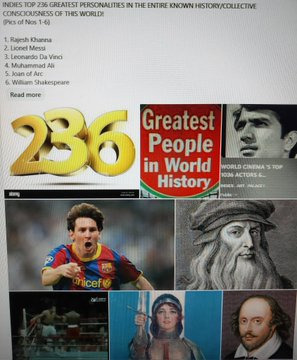


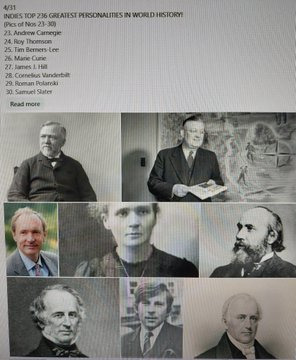
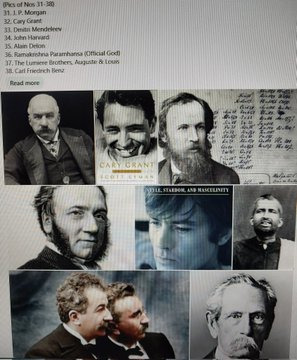
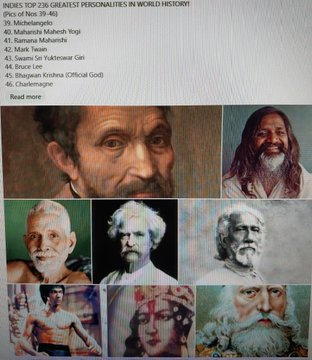
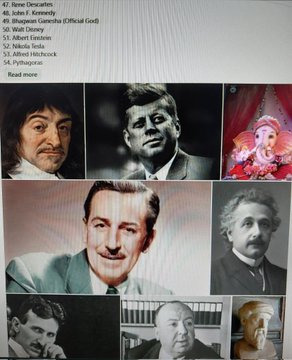
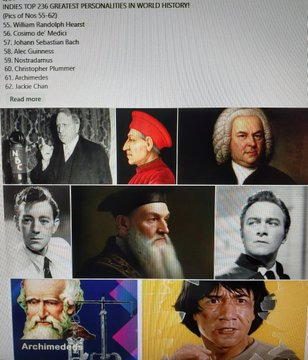
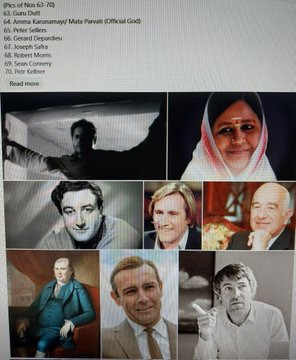
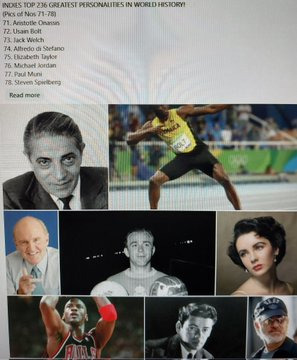
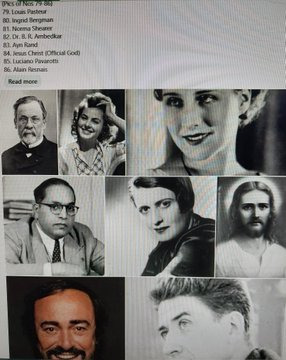
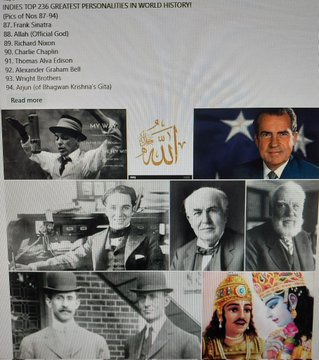
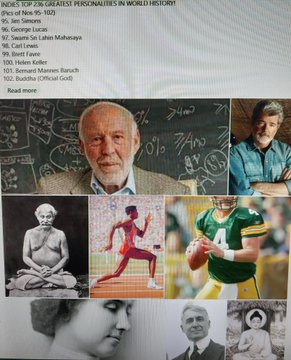
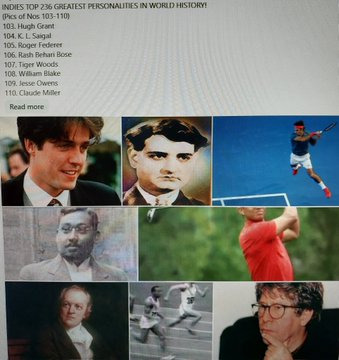
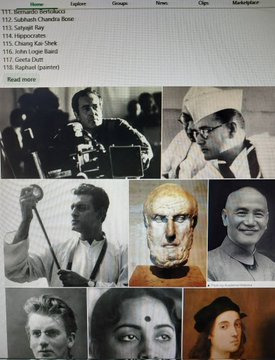
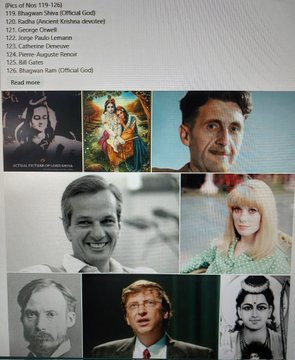
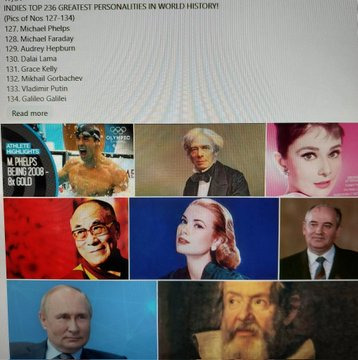
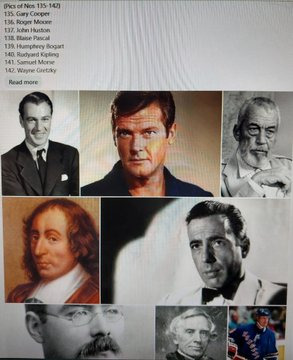
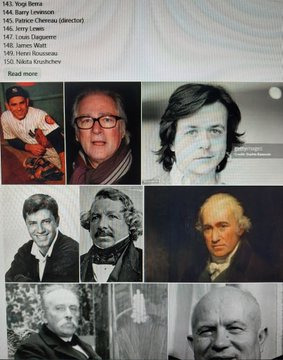
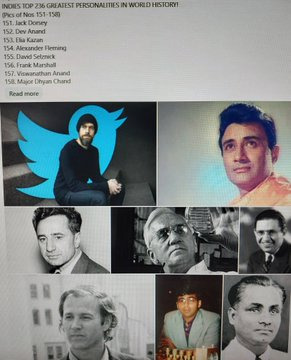
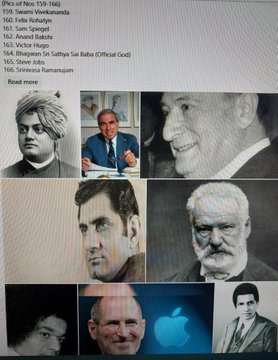
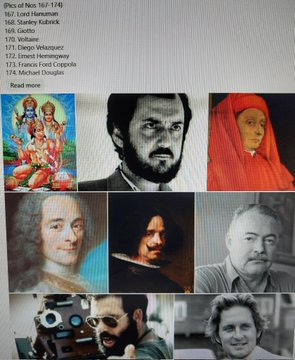
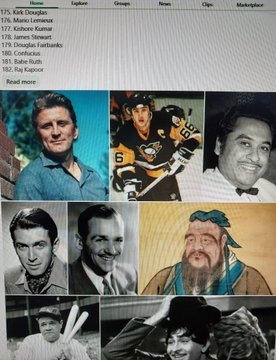
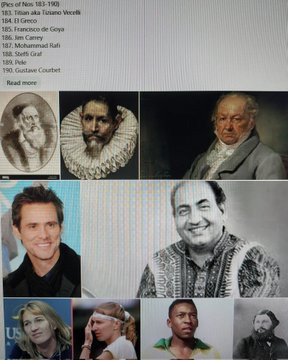
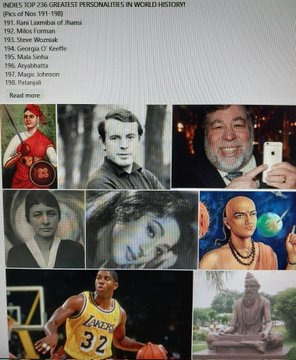
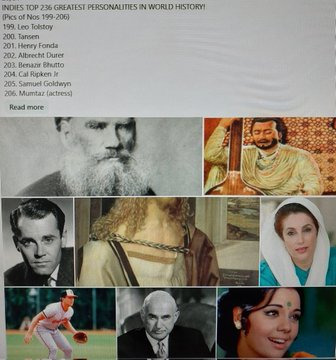

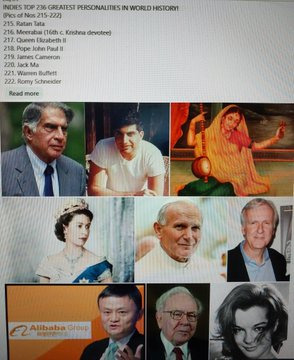
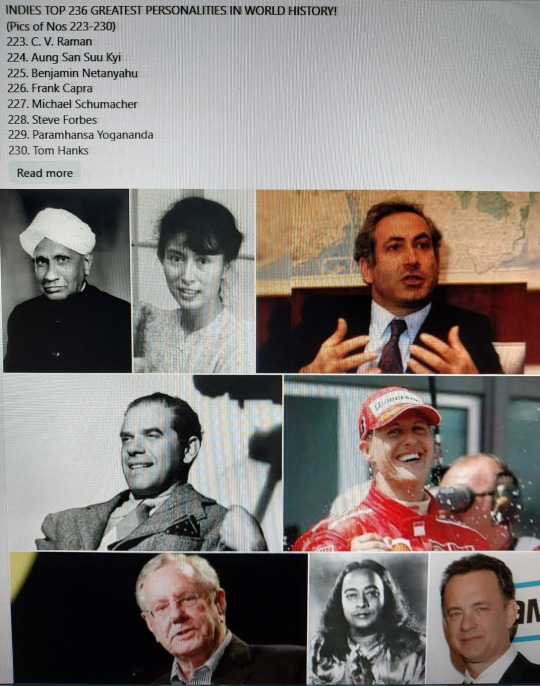
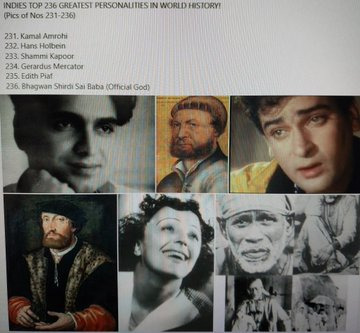
4 notes
·
View notes
Text
Erhard Wienkamp: Messe Düsseldorf operative managing director to retire

Erhard Wienkamp has worked in various functions at Messe Düsseldorf since 1993. After holding positions in the foreign trade department of the Federation of German Wholesale and Foreign Trade in Bonn and the German-Argentinean Chamber of Industry and Commerce in Buenos Aires, he took over the project management of the Papro, K and interpack trade shows at the beginning of his trade show career.
Since 2002, the economics graduate has been responsible for Messe Düsseldorf’s international trade show business as divisional manager and authorized signatory. In this role, he was also responsible for partner and guest events, official participations such as the joint exhibition booths of the Federal Republic of Germany and the State of North Rhine-Westphalia, special events, and the management of Messe Düsseldorf’s international shows.
Erhard Wienkamp succeeded Hans Werner Reinhard as operative managing director in January 2020. In this role, he was responsible for the Plastics & Rubber portfolio with the leading global trade show K and nine trade shows abroad; the Health & Medical Technologies portfolio (Medica, Compamed, Rehacare and nine trade shows abroad); the Caravaning & Outdoor portfolio (Caravan Salon Dusseldorf and All in Caravaning in Beijing); the Wine & Spirits portfolio (ProWein and six trade shows abroad); and the Print Technologies portfolio (drupa, Print & Digital Convention and four trade shows abroad). He was also responsible for the areas Retail & Retail Technologies (EuroShop and EuroCIS in Düsseldorf, China in-store in Shanghai and in-store asia in Mumbai); Occupational Safety & Health (A+A and five trade shows abroad); Glass Technologies (glasstec and three trade shows abroad); and Beauty (Beauty Dusseldorf, Top Hair). Moreover, he led the corporate social responsibility unit and two of the three sales teams at Messe Düsseldorf. Erhard Wienkamp was also in charge of international participations and services; special events, which includes the German Houses at the Olympic and Paralympic Games; conference management; and the international business department.
Dr. Stephan Keller, lord mayor of the state capital Düsseldorf and chairman of the Supervisory Board of Messe Düsseldorf, is grateful for Erhard Wienkamp, “The trade shows that Erhard Wienkamp is responsible for are heavyweights in their industry, bringing people from all over the world to Düsseldorf year after year and not only enriching the international flair of our city but also promoting the regional economy.” The 78% of the 24,469 exhibiting companies in Düsseldorf in 2023 hailing from abroad meant the highest level of internationality among exhibitors ever (previous year: 75%), and with 39% of the 1,074,870 attendees coming from outside Germany, the share of international visitors was the second highest to date (previous year: 46%).
The global presence of Messe Düsseldorf, which Erhard Wienkamp had helped to promote, contributed greatly to these results, says Dr. Keller. The foreign trade shows and joint booths organized internationally by Messe Düsseldorf serve as powerful showpieces for Düsseldorf as a trade show and business location. Messe Düsseldorf’s portfolio now includes 73 events abroad, plus 25 trade shows at the home base.
Wolfram N Diener, president & CEO of Messe Düsseldorf, emphasized Erhard Wienkamp’ s immense contribution to the company’s success, “Erhard Wienkamp didn’t wait for the world to come to Düsseldorf, he went out into the world and carried the reputation of Messe Düsseldorf and the entire city to other countries and continents. His work has shaped the company like no one else’s.”
As of August 1, the 66-year-old will be succeeded in his function as operative managing director by Marius Berlemann. Having worked at Messe Düsseldorf for 13 years, the 38-year-old Berlemann most recently served as General Manager of Messe Düsseldorf Shanghai and managing director of Messe Düsseldorf China.
Erhard Wienkamp looks back on his time at Messe Düsseldorf with pride and gratitude, “It’s been an honor to be part of such a dynamic and dedicated team, one that has always strived to set the highest standards in the trade show industry. I’m confident that my successor, with his extensive experience and commitment, will continue to propel Messe Düsseldorf forward. I wish him and the entire team nothing but success for the future.”
0 notes
Text
Ort: KAS-Akademie, Tiergartenstraße 35, Berlin-Tiergarten
Datum: 1. Juli 2024 Beginn: 14:00 Uhr
Öffentliche juristische Fachtagung
Documenta 15, die Berlinale, diverse Ausstellungen und Performances mit antisemitischen Inhalten werfen immer wieder die Frage auf: Was muss der freiheitliche Staat aufgrund der Kunst-, Meinungs- und Wissenschaftsfreiheit hinnehmen? Wo gibt es verfassungsrechtliche Spielräume für regulierendes Eingreifen? Muss der Staat auch antisemitische Inhalte finanzieren? Oder darf der Staat im Zuwendungsrecht die Mittelvergabe an Bedingungen binden, die gewährleisten, dass der Schutz der Menschenwürde, der freiheitlichen demokratischen Grundordnung und der Gedanke der Völkerverständigung zumindest nicht gefährdet werden?
Antisemitismus verstößt gegen den Schutz der Menschenwürde und die freiheitlich-demokratische Grundordnung. Dies hat das Bundesverfassungsgericht zuletzt im II. NPD-Urteil festgehalten. Seit dem 7. Oktober 2023 nehmen die Anzahl und die Intensität antisemitischer Vorfälle in Deutschland massiv zu. Aber schon zuvor gab es immer wieder Diskussionen um Antisemitismus, Boykotte und Boykotteure von israelischen Künstler:innen und Wissenschaftler:innen in öffentlich finanzierten Einrichtungen.
Die Frage, ob der freiheitliche demokratische Staat, der dem Schutz der Menschenwürde verpflichtet ist, bei seiner Mittelvergabe an Dritte eine Selbstparadoxierung hinnehmen müsse, hat die Politik zuletzt bei der Parteienfinanzierung und dem Stiftungsfinanzierungsgesetz diskutiert.
Eine Auseinandersetzung über die rechtlichen Mittel gegen Antisemitismus und geeignete Maßnahmen zur Antisemitismusbekämpfung sind wichtiger denn je. In mehreren Veranstaltungen sollen die rechtlichen Grundlagen im Kampf gegen Antisemitismus und die Möglichkeiten zu ihren Verbesserungen mit Praktiker:innen und Wissenschaftler:innen aus Antisemitismusforschung und -prävention, Rechtswissenschaft, Justiz und Politik analysiert und diskutiert werden.
Die juristische Fachtagung “Kein Geld für Antisemitismus?!” widmet sich dem Zuwendungs- und Gemeinnützigkeitsrecht und diskutiert, welche Möglichkeiten und Grenzen in Bezug auf die Antisemitismusbekämpfung in diesen Rechtsbereichen existieren.
Bitte zur Veranstaltung hier anmelden
PROGRAMM
14:00 – 14:15
Grußworte
Dr. Felix Klein (Beauftragter der Bundesregierung für jüdisches Leben in Deutschland und den Kampf gegen Antisemitismus)
RA Daniel Botmann (Geschäftsführer des Zentralrats der Juden in Deutschland)
Dr. Andreas Jacobs (Konrad-Adenauer-Stiftung)
Volker Beck (Geschäftsführer Tikvah Institut)
14:15 – 14:35
Input 1: Bedeutung, Möglichkeiten und Grenzen des Zuwendungsrechts
RAin Dr. Hannah Rubin (Eichler Kern Klein Rechtsanwälte, Berlin)
14:35 – 14:55
Input 2: Staatliche Kunstförderung und Antisemitismus: Bedeutung, Möglichkeiten und Grenzen von Förderrichtlinien
Dr. Nina Keller-Kemmerer (Universität Gießen)
14:55 – 15:15
Input 3: Strategien gegen Antisemitismus in staatlich verantworteten Räumen. Grundrechtliche Bindungen und rechtliche Handlungsmöglichkeiten
Prof. Dr. Hans Michael Heinig (Georg-August-Universität Göttingen)
15:15 – 15:35
Input 4:
Prof. Dr. Christoph Möllers (Humboldt-Universität zu Berlin)
15:35– 15:55
Input 5: Antisemitismus als Rechtfertigungsgrund für Ungleichbehandlung: Was sagt das Verfassungsrecht?
RA Dr. Patrick Heinemann (Bender Harrer Krevet Rechtsanwälte, Freiburg)
15:55 – 16:15
Kaffeepause
16:15 – 16:35
Input 6: Grundrechtliche Grenzen bei vergaberechtlichen Entscheidungen?
Prof. Dr. Kyrill-Alexander Schwarz (Universität Würzburg)
16:35 – 16:55
Input 7: Erfahrungen aus Schleswig-Holstein
N.N. (Ministerium für Bildung, Wissenschaft und Kultur des Landes Schleswig-Holstein)
16:55– 17:15
Input 8: Das Gemeinnützigkeitsrecht als Trennlinie zu Demokratie-Feinden – inklusive Stolpersteinen
Stefan Diefenbach-Trommer (Allianz “Rechtssicherheit für politische Willensbildung”)
17:15 – 18:00
Streitgespräch
moderiert von Frederik Schindler
Prof. Dr. Christoph Möllers (Humboldt-Universität zu Berlin) [angefragt]
RA Dr. Patrick Heinemann (Bender Harrer Krevet Rechtsanwälte, Freiburg)
18:15 – 18:30
Begrüßung
Prof. Dr. Verena Blechinger-Talcott (stellv. Vorsitzende Konrad-Adenauer-Stiftung)
18:15 – 20:00
Öffentliche Podiumsdiskussion
moderiert von N.N.
Gitta Connemann (MdB, CDU)
Dr. Thorsten Lieb (MdB, FDP)
Dr. Sergey Lagodinsky (MdEP, Grüne)
Martin Matz (MdA, SPD)
im Anschluss
Abendimbiss
Diese Veranstaltung ist Teil des Projekts „Jeda“.
Stand des Programmes: 24. Juni 2024
2 notes
·
View notes
Text



















The Circle 5.0
Hans Peter Hiby: sax
John Dikeman: sax
Reza Askari: db
Shoji Hano: dr
Willi Kellers: dr
17.9.2023 / Club W71
1 note
·
View note
Text
German tv shows with lgbt* characters
I think it can be quite hard to find queer german tv shows, so I thought I‘d compile a list with the ones that I have watched so far.
✪ = queerness is centered in this show
A-Z
1899 (2022) (mlm) | Netflix | international
Ángel (Miguel Bernardeau)
Ramiro (José Pimentão)
Krester (Lucas Lynggaard Tønnesen)
All you need (2021-) (mlm) | ZDF | ✪
Vince (Benito Bause)
Robbie (Frédéric Brossier)
Levo (Arash Marandi)
Tom (Mads Hjulmand)
Andreas (Tom Keune)
Barbaren (2020-) (mlm) | Netflix
Marbod (Murathan Muslu)
Flavus (Daniel Donsky)
Beat (2018) (mlm) | Prime Video
Beat (Jannis Niewöhner)
Becoming Charlie (2022-) (trans, mlm, wlw) | ZDF | ✪
Charlie (Lea Drinde)
Ronja (Sira-Anna Faal)
Mirko (Antonije Stankovic)
Blutige Anfänger (2020-) (mlm) | ZDF, YT
Michael Kelting (Werner Daehn)
Dr. Claas Steinebach (Martin Bretschneider)
Bruno Pérez (Martin Peñaloza Cecconi)
Phillip Schneider (Eric Cordes)
Charité (2017-) (wlw, mlm) | Netflix
Schwester Therese (Klara Deutschmann)
Otto Marquardt (Jannik Schümann)
Martin Schelling (Jacob Matschenz)
Dark (2017-2020) (wlw, mlm, trans) | Netflix
Peter Doppler (Stephan Kampwirth)
Bennie Wöller (Anton Rubtsov)
Doris Tiedemann (Tamar Pelzig/Luise Heyer)
Agnes Nielsen (Helena Pieske/Antje Trauer)
Deutschland 83/86/89 (2015-2020) (wlw, mlm) | Prime Video
Alex Edel (Ludwig Trepte)
Prof. Tobias Tischbier (Alexander Beyer)
Lenora Rauch (Maria Schrader)
Rose Seithathi (Florence Kasumba)
Dogs of Berlin (2018) (mlm) | Netflix
Erol Birkan (Fahri Yardim)
Guido Mack (Sebastian Achilles)
Dr. Klein (2014-2019) (mlm) | Netflix
Patrick Keller (Leander Lichti)
Kaan Gül (Karim Günes)
DRUCK (2018-) (wlw, mlm, trans) | YT | ✪
Fatou Jallow (Sira-Anna Faal)
Matteo Florenzi (Michelangelo Fortuzzi)
Zoe Machwitz (Madeleine Wagenitz)
Kieu My Vu (Nhung Hong)
Isi Inci (Eren M. Güvercin)
David Schreibner (Lukas von Horbatschewsky)
Yara Aimsakul (Elena Plyphalin Siepe)
Hans Brecht (Florian Appelius)
Eldorado KaDeWe – Jetzt ist unsere Zeit (2021-) (wlw) | ARD
Heidi Kron (Valerie Stoll)
Fritzi Jandorf (Lia von Blarer)
How to Sell Drugs Online (Fast) (2019-) (wlw) | Netflix
Fritzi (Leonie Wesselow)
Gerda (Luna Baptiste Schaller)
Kitz (2021) (mlm) | Netflix
Kosh Ziervogel (Zoran Pingel)
Hans Gassner (Ben Felipe)
Ku‘damm 56/59/63 (2016-2021) (mlm) | ZDF
Wolfgang von Boost (August Wittgenstein)
Hans Liebknecht (Andreas Pietschmann)
Der Kroatien Krimi/Split Homicide (2016-) (wlw) | ARD
Stascha Novak (Jasmin Gerat)
Loving Her (2021) (wlw) | ZDF | ✪
Hanna (Banafshe Hourmazdi)
Holly (Bineta Hansen)
Franzi (Lena Klenke)
Lara (Emma Drogunova)
Josephine (Karin Hanczewski)
Anouk (Larissa Sirah Herden)
Sarah (Soma Pysall)
Mord mit Aussicht (2018-2022) (wlw) | Netflix
Bärbel Schmied (Meike Droste)
Neumatt (2021-) (mlm) - Switzerland | Netflix
Michi Wyss (Julian Koechlin)
Joel Bachmann (Benito Bause)
Polizeiruf 110 (1971-) (queer/gnc) | ARD
Frankfurt/Świecko
Vincent Ross (Andre Kaczmarczyk)
SOKO Leipzig (2001-) (mlm) | ZDF
Moritz Brenner ( Johannes Hendrik Langer )
Tatort (1970-) (mlm, wlw) | ARD
Berlin
Robert Karow (Mark Waschke)
Hamburg
Julia Grosz (Franziska Weisz)
Saarbrücken
Esther Baumann (Brigitte Urhausen)
Wien
Meret Schande (Christina Scherrer)
Vorstadtweiber (2015-) (mlm) – Austria
Georg Schneider (Jürgen Maurer)
Joachim Schnitzler (Phillip Hochmair)
WIR (2021-) (wlw) | ZDF
Annika Baer (Eva Maria Jost)
Helena Kwiatkowski (Katharina Nesytowa)
Wendland (2023-) (wlw) | ZDF
Kira Engelmann (Paula Kalenberg)
Birthe (?)
Queer Eye Germany (2022) (mlm, nblm, trans) | Netflix
Avi Jakobs
Leni Bolt
Ayan Yuruk
Jan-Henrik Scheper-Stutke
Aljosha Muttardi
Notes: I may have forgotten to add some characters, because for most of the shows it has been some time since I last watched them. Please let me know if you want me to add a character or even show:)
#german#queer#lgbt#TV series#queer representation#lgbt representation#1899 netflix#all you need zdf#barbaren netflix#beat prime video#becoming charlie#blutige anfänger#charite#dark netflix#Deutschland 83#dogs of berlin#dr. klein#druck#eldorado kadewe#how to sell drugs online (fast)#kitz netflix#kudamm 56#deutschland 89#kroatien krimi#loving her zdf#mord mit aussicht#tatort#tatort saarbrücken#tatort berlin#polizeiruf 110
466 notes
·
View notes
Text

On May 14, 1967, Syd Barrett and Roger Waters were interviewed by musicologist Dr. Hans Keller on the BBC program "Look Of The Week". 🎧
The reviewer noted that Pink Floyd's music was "terribly loud" and "a throwback to childhood". On that same show they performed "Pow R. Toc H." and "Astronomy Dominé". 🎧
#pinkfloyd#syd barrett#roger waters#retro#r.i.p.#gone too soon#singer#lyrics#songwriter#bass guitar#bbc tv shows#1967
39 notes
·
View notes
Text
Request!!
Hey there!
I am dedicating this blog solely to writing fanfiction.
I seem to struggle with writers block and would really appreciate requests from you guys! I will list the people I most enjoy writing for but feel free to request anyone, I may not be able to write it for you if I don’t know the person requested or feel I wouldn’t do a good job portraying what you want. But I shall try my very best!
CHARACTERS:
INGLOURIOUS BASTERDS:
- Sgt. Donny Donowitz
- Lt. Aldo Raine
- Sgt. Hugo Stiglitz
- Hans Landa
- Shosanna Dreyfus
- Frederick Zoller
- Bridget Von Hammersmark
- Lt. Archie Hicox
- Major Dieter Hellstrom
- PFC Utivich
- PFC Hirschberg
- Cpl. Willhelm Wicki
- Perrier LaPadite
- PFC Omar Ulmer
STAND BY ME:
- Gordie Lachance
- Chris Chambers
- Vern Tessio
- Teddy Duchamp
- Richard “Eyeball” Chambers
- Ace Merrill
- Denny Lachance
- Billy Tessio
- Charlie Hogan
MISS PEREGRINE’S HOME FOR PECULIAR CHILDREN:
- Enoch O’ Connor
- Miss Alma Peregrine
- Jacob Portman
- Emma Bloom
- Abraham Portman
- Olive Abroholos Elephanta
THE MAZE RUNNER:
- Gally
- Newt
- Thomas
- Minho
- Teresa
- Frypan
- Alby
- Ben
- Zart
- Brenda
- Aris
- Janson
- Jorge
- Vince
- Lawrence
TWILIGHT:
- Bella Swan
- Edward Cullen
- Jasper Hale/Cullen
- Emmett Cullen
- Rosalie Hale/Cullen
- Alice Cullen
- Dr. Carlisle Cullen
- Esme Cullen
- Victoria
- James
- Laurent
- Jacob Black
- Seth Clearwater
- Leah Clearwater
- Sam Uley
- Charlie Swan
- Paul
- Emily
- Jared
SONS OF ANARCHY:
- Jackson “Jax” Teller
- Tara Knowles
- Gemma Teller
- Nero Padilla
- Clay Morrow
- Harry “Opie” Winston
- Lyla Winston
- Juan Carlos “Juice” Ortiz
- Filip “Chibs” Telford
- Kerianne Telford
- Bobby “Fat Elvis” Munson
- Alexander “Tig” Trager
- Happy Lowman
- Wendy Case
- George “Ratboy” Skogstrom
- Herman Kozik
- Rane Quinn
- Otto Delaney
- Keith McGee
- Cherry
- Luann Delaney
DIVERGENT:
- Eric Coulter
- Tobias “Four” Eaton
- Peter
- Will
YOU:
- Joe Goldberg
- Karen Minty
THE SOCIETY:
- Gareth “Grizz” Visser
- Allie Pressman
- Cassandra Pressman
- Campbell Eliot
- Sam Eliot
- Kelly Aldrich
- Elle Tomkins
- Will LeClair
- Bean
- Helena
- Harry Bingham
- Gordie
- Luke
RIVERDALE:
- Sweet Pea
- Jughead Jones
- Archie Andrews
- Cheryl Blossom
- Toni Topaz
- Kevin Keller
- F. P. Jones
SHERLOCK:
- Sherlock Holmes
- Moriarty
- John H. Watson
- Mycroft Holmes
- Inspector Lestrade
- Molly Hooper
- Mary Morstan
SUPERNATURAL:
- Dean Winchester
- Sam Winchester
- Castiel
- Crowley
- Lucifer
- Charlie
- Bobby Singer
- Gabriel
- John Winchester
- Mary Winchester
- Jo Harvelle
- Meg Masters
- Arthur Ketch
- Bela Talbot
- Kevin Tran
- Jody Mills
- Adam Milligan
- Chuck Shurley
I am more than happy to attempt any character on this list or not. PLEASE SEND REQUESTS! :) I am also happy to do cross-overs and ships, as well as writing two characters together. Every type of request is welcome, be it, polyamorous, gay, lesbian, smut, fluff, kink, mental illness or any other subject that may be difficult to ask for, all is welcome here and I will do my very best with the knowledge I have!
I look forward to writing your stories! Request away!
Mulvs :)
38 notes
·
View notes
Text
Best Family Quotes For Travelling with Children

Traveling with children is a great way to share laughs, adventure and new experiences. Here is a collection of the best family travel quotes which will inspire you on your travels and encourage your family’s wandering soul.
1 | “As soon as I saw you, I knew an adventure was about to happen.” – A. A. Milne, Winnie the Pooh
2 | "Travelling in the company of those we love is home in motion" – Leigh Hunt
3 | "Oh the places you’ll go" - Dr. Seuss
4 | "What child has not travelled by spinning the globe" – Anon
5 | "And at the end of the day, your feet should be dirty, your hair messy and your eyes sparkling.” – Shanti
6 | "Not all classrooms have 4 walls" – Anon
7 | "Actually, the best gift you could have given her was a lifetime of adventures" - Lewis Carroll
8 | "The moment you doubt whether you can fly, you cease forever to be able to do it" – Peter Pan J.M. Barrie

9 | "Wherever you go becomes a part of you somehow" – Anita Desai
10 | "Kid, you’ll move mountains” - Dr. Seuss
11 | “The best education you will ever get is traveling. Nothing teaches you more than exploring the world and accumulating experiences.” - Mark Paterson
12 | "Every day we make deposits in the memory banks of our children" –Charles R Swindoll
13 | "It’s a magical world, Hobbes, ol’ buddy… Let’s go exploring!” - Calvin from Calvin and Hobbes
14 | “The biggest adventure you can ever take is to live the life of your dreams.” - Oprah Winfrey
15 | "To travel is to live" – Hans Christian Anderson
16 | “Can you remember who you were before the world told you who you should be.” – Danielle Laporte
17 | "Don’t tell me the sky’s the limit when there are footsteps on the moon" - Paul Brandt
18 | "People do not decide to become extraordinary. They decide to accomplish extraordinary things.” - Edmund Hillary
19 | "Take only memories, leave only footprints" - Chief Seattle
20 | "Life is either a daring adventure or nothing at all" - Helen Keller

21 | "Because when you stop and look around, this life is pretty amazing.” - Dr. Seuss
22 | "Travel is like an endless university. You never stop learning" - Harvey Lloyd
23 | "I do believe it's time for another adventure.” - Unknown
24 | “Every sunset is also a sunrise. It all depends on where you stand" - Karl Schmidt
25 | “From there to here, and here to there, funny things are everywhere.” - Dr.Seuss
26 | "Wherever you go, go with all your heart." - Confucius
27 | "Where you lead, I will follow." - Carole King
28 |“Teaching kids to count is fine, but teaching them what counts is best.” - Bob Talbert.
29 | "The greatest legacy we can leave our children is happy memories" - Og Mandino
30 | "Educating the mind without educating the heart is no education at all" – Aristotle
For more great adventure content, check out www.ovymedia.com today.
1 note
·
View note
Text
CONTRIBUCIÓN DE LOS SUPLEMENTOS EN LA RECUPERACIÓN FUNCIONAL DE TRASTORNOS COGNITIVOS.
CONTRIBUCIÓN DE LOS SUPLEMENTOS EN LA RECUPERACIÓN FUNCIONAL DE TRASTORNOS COGNITIVOS.
Introducción.
Se ha demostrado en los últimos 30 años que todos los trastornos neurológicos y psiquiátricos muestran alteraciones orgánicas y o funcionales.
Algunos por déficit en el desarrollo del SNC que generalmente se relacionan con deficiente generación neuronal o sináptica, otros por alteraciones secundarias a daño neuronal como hipoxia, isquemia, traumatismos, neuroinfecciones, tóxicos, etc.
Las consecuencias de estos eventos son un sistema nervioso central alterado, con la consecuente disfunción cognitiva que caracteriza a múltiples trastornos como son:
AUTISMO, DEFICIT DE ATENCION (ADHD), EPILEPSIA, DEMENCIAS COMO ALZHEIMER O de origen VASCULAR, PARKINSON, ESQUIZOFRENIA, TRASTORNO BIPOLAR, ETC.
Los SUPLEMENTOS nutricionales, son moléculas derivadas de alimentos, que incluyen a una gran diversidad de moléculas, tanto proteicas como no proteicas, dentro de las que se incluyen especialmente las citoquinas, vitaminas, minerales y polifenoles, entre otras.

El propósito de esta charla es analizar la contribución de algunos de ellos en la recuperación funcional de los trastornos mencionados.
La contribución de las citoquinas que incluyen a los factores de crecimiento y neurotrófico, en la regulación de la neurogénesis y la recuperación funcional de las alteraciones cerebrales previamente mencionadas se le dará énfasis especial.
Por parte de las vitaminas se dará énfasis en la contribución de la vitamina D en la regulación neuronal y desarrollo, en las patologías mencionadas.
Mencionando también a otras vitaminas y minerales.
GENERALIDADES DE CITOQUINAS.
Son moléculas proteicas o peptídicas de bajo peso molecular que contribuyen a la regulación de la función celular.
Algunas de ellas como el HGF (factor de crecimiento derivado de hepatocitos), FGF2 (factor de crecimiento fibroblástico 2) tienen especial importancia por ser capaces de inducir o incrementar la generación de neuronas y de esta manera contribuyen a la reparación de daños o favorecen la recuperación funcional incrementando el desarrollo de ciertas regiones o circuitos hipo desarrollados por causas genéticas o congénitas que generan patologías como las ya mencionadas en la introducción.
AUTISMO.
ANORMALIDADES ORGÁNICO-FUNCIONALES DEL CEREBRO DEL AUTISTA.
Muchos investigadores han contribuido con su esfuerzo en obtener información de las regiones y circuitos alterados en el cerebro autista. (Rubenstein y Merzenich, 2003; Belmonte et al., 2004; Courchesne, 2004; Casanova, 2007; Minshew y Williams, 2007; Amaral et al., 2008) entre otros, más recientemente. Kamila y Henry Markman (Front Hum Neurosci. 2010; 4: 224.)
Ellos proponen un híper funcionamiento de circuitos lo cual genera híper- reactividad, híper- percepción, híper-atención, híper-memoria e híper-emocionalidad, esto es apoyado en parte por la deficiencia del neurotransmisor inhibidor Gaba, en un porcentaje alto de autistas (aprox. 80%). Este déficit en Gaba, se ha relacionado con alteraciones en el receptor MET el cual enlaza al HGF ya mencionado y es fundamental para la generación y migración de neuronas gabaérgicas, además de estar implicado en procesos de desarrollo neurológico, incluyendo sinaptogénesis y la alteración funcional de este receptor se relaciona con ciertos subtipos de autismo. (Peng et al., 2013) (Campbell et al., 2006, 2007), (Rudie et al., 2012) (Hedrick et al., 2012).
Por otra parte, Minshew NJ1 and Keller TA. (Curr Opin Neurol. Abr 2010)
utilizando estudios de resonancia magnética funcional detectan alteraciones en regiones parieto-occipitales. y en las redes frontoestriatales que participan en el control cognitivo. Los hallazgos sugieren que la especialización de muchas redes corticales del cerebro humano no se desarrolla adecuadamente en individuos con autismo de alto funcionamiento.
El trastorno del espectro autista (TEA) es un trastorno que presenta alteraciones en lenguaje, comportamiento social, cognitivo y emocional, pero que también altera aspectos sensoriales y en menor grado motores lo que se asocia a un desempeño deficiente en autosuficiencia. Weston CSE. Basado en investigaciones previas sugiere que son cuatro regiones del cerebro social las implicadas en la sintomatología del TEA: amígdala, corteza orbito frontal (OFC), corteza temporo parietal (TPC) e ínsula.
El modelo está respaldado por pruebas de neuroimagen, neuropsicológicas, neuroanatómicas, celulares, fisiológicas y conductuales.
Por nuestra parte hemos utilizado herramientas neurofisiológicas, especialmente potenciales relacionados a eventos y análisis de coherencia, estas pruebas se realizan durante tareas que demandan esfuerzo y miden la actividad cerebral durante funciones especificas. Los resultados de dichas pruebas han demostrado 3 diferentes subgrupos de autistas. El 64% ha mostrado alteraciones funcionales en regiones parieto temporales, predominio izquierdo, pero frecuentemente afecta también a la región derecha.

El 2do grupo (40%) muestra alteraciones de regiones fronto temporales, mas común en hemisferio derecho, otro 16% muestra alteraciones muy similares a las observadas en esquizofrenia típica o común que altera en forma generalizada a la corteza cerebral y en la cual se demuestra deficiencia en la población neuronal gabaérgica. El porcentaje superior al 100% se debe a que el 20% de los pacientes muestra alteraciones tanto parieto temporales como fronto temporales.
SUPLEMENTOS QUE HAN MOSTRADO FAVORECER LA RECUPERACIÓN FUNCIONAL EN PACIENTES CON ESPECTRO AUTISTA.
Las citoquinas ya mencionadas por su capacidad de inducir neurogénesis y favorecer la generación de dendritas, axones y sinapsis, así como incrementar la síntesis de neurotransmisores, favorecen el incremento de la función de circuitos neuronales específicos, por ejemplo, el FGF2 favorece el desarrollo de neuronas principales o glutamatérgicas, el HGF de neuronas gabaérgicas y el GCSF y SCF neurogénesis, cada uno con predominio gabaérgica o glutamatérgico.
Por lo anterior la elección de cada una de estas citoquinas dependerá de los resultados de los estudios neurofisiológicos.
En general un porcentaje alto de pacientes muestran datos de desconexión e hipo actividad funcional en regiones específicas, lo anterior correlaciona con hipo desarrollo o daño de neuronas glutamatérgicas, por lo que en esos casos el FGF2 es fundamental en el tratamiento, por otra parte como ya mencionamos antes alrededor de un 80% de los pacientes autistas muestran datos de deficiencia de la actividad de neuronas gabaérgicas, ya sea por alteraciones del desarrollo como es el caso de mutaciones o polimorfismos del receptor MET (ya mencionado) o por daño y perdida de neuronas gabaérgicas asociadas a causas exógenas como hipoxia-isquemia perinatal, traumatismos, neuroinfecciones, etc.
En estos casos en HGF es fundamental, y especialmente asociado al GCSF, ambos forman una asociación excelente para generar y desarrollar neuronas gabaérgicas, contribuyendo importantemente a la recuperación funcional del espectro autista con estas características.
Los resultados son progresivos y en general requieren más de dos años de tratamiento. Las mejoras son confirmadas tanto por análisis neuropsicológicos como neurofisiológicos, mejorando inicialmente en darse cuenta de que lo sucede en su entorno, compresión verbal, luego socialización, después juego imaginativo y finalmente conducta y expresión verbal.
Dr. Luis Carlos Aguilar Cobos.
Contacto:
Email: [email protected]
Whatsapp: 52 1 3316052297
REFERENCIAS.
eNeuro. 2016 Aug 29;3(4). pii: ENEURO.0074-16.2016. Hepatocyte Growth Factor Modulates MET Receptor Tyrosine Kinase and β-Catenin Functional Interactions to Enhance Synapse Formation.
Xie Z1, Eagleson KL1, Wu HH1, Levitt P2.
Biol Psychiatry. 2017 Mar 1;81(5):424-433.
The Pleiotropic MET Receptor Network: Circuit Development and the Neural-Medical Interface of Autism.
Eagleson KL1, Xie Z2, Levitt P3
Mol Psychiatry. 2016 Jul;21(7):925-35. The autism-associated MET receptor tyrosine kinase engages early neuronal growth mechanism and controls glutamatergic circuits development in the forebrain.
Peng Y1, Lu Z1,2, Li G1,3, Piechowicz M1, Anderson M1, Uddin Y1, Wu J4, Qiu S1,3
Brain Connect. 2019 Feb;9(1):13-21.
Revisiting Abnormalities in Brain Network Architecture Underlying Autism Using Topology-Inspired Statistical Inference.
Palande S1,2, Jose V2, Zielinski B3,4, Anderson J5, Fletcher PT1,2, Wang B1,2.
PLoS One. 2012;7(11):e49172.
scMRI reveals large-scale brain network abnormalities in autism.
Zielinski BA1, Anderson JS, Froehlich AL, Prigge MB, Nielsen JA, Cooperrider JR, Cariello AN, Fletcher PT, Alexander AL, Lange N, Bigler ED, Lainhart JE.
Curr Opin Neurol. 2010 Apr;23(2):124-30.
The nature of brain dysfunction in autism: functional brain imaging studies.
Minshew NJ1, Keller TA.
ont Hum Neurosci. 2010; 4: 224.
The Intense World Theory – A Unifying Theory of the Neurobiology of Autism
Kamila Markram1,* and Henry Markram1
J Pediatr (Rio J). 2016 Nov - Dec;92(6):595-601.
Prenatal, perinatal and postnatal factors associated with autism spectrum disorder.
Hadjkacem I1, Ayadi H2, Turki M2, Yaich S3, Khemekhem K2, Walha A2, Cherif L2, Moalla Y2, Ghribi F2
Brain Sci. 2019 Jun 4;9(6). pii: E130.
Four Social Brain Regions, Their Dysfunctions, and Sequelae, Extensively Explain Autism Spectrum DisorderSymptomatology.
Weston CSE1.
1 note
·
View note
Text
#WirVergessenNicht – Der Fall Fritzl und die blinde Justiz!

Josef FRITZL hat seine Tochter in einem Keller gefangen gehalten und sie ca. 3.000-mal sexuell missbraucht. Mit ihr hat er im Kellerverlies 7 Kinder gezeugt. Rückblickend behaupteten Nachbarn etwas gehört, einer meint sogar von den Vergewaltigungen der Tochter gewusst zu haben. Es ist aber eine typisch menschliche Eigenschaft nichts zu sagen, zu hören und wegzuschauen. Gerüchte sind in kleinen Städten üblich und ihr Wahrheitsgehalt oft fraglich. 2009 wird FRITZL nach seiner Verurteilung in eine Anstalt für geistig abnorme Straftäter untergebracht. Mittlerweile besitzt der an Demenz Erkrankte eine neue Identität, damit ihn Neuankömmlinge in der Justizanstalt nicht erkennen. Für € 545,60 Euro lässt er sich in „Fritz Mayrhoff“ umbenennen. Er ist von seiner Frau geschieden und seine Kinder haben neue Identitäten. Bei der Linzer Polizei ist FRITZL bekannt, da er wegen Exhibition und Notzucht polizeilich registriert ist. Nach einer 1 ½-jährigen Haftstrafe kehrt der Vergewaltiger zu seiner Frau Rosemarie zurück. Die Zeitungen berichten darüber. Wie kann es sein, dass die Polizei in Amstetten, obwohl nur eine halbe Stunde von Linz entfernt, nichts vom Akt in Linz weiß? Herr Hofrat Hans-Heinz Lenze, der Bezirkshauptmann, hat eine Antwort: “Im Strafregister der Bundespolizeidirektion Wien scheint keine Verurteilung auf”. Anscheinend ist die Haftstrafe im Strafregister der Bundespolizeidirektion in Wien gelöscht. 21-mal kontaktiert die Familie FRITZL die Jugendwohlfahrt Amstetten, doch niemand schöpft Verdacht. Seine Frau und er nehmen die abgelegten Kinder als Verwandtenpflegekinder an, dafür bekommen sie eine Zuzahlung von rund € 12.000 jährlich zur Familienbeihilfe. - https://www.oe24.at/oesterreich/chronik/niederoesterreich/das-ist-der-fall-fritzl/401921751 - https://www.stern.de/politik/deutschland/josef-fritzl–ein-ordentlicher-tyrann—zehn-jahre-horror-von-amstetten-3855548.html

Es ist eindeutig ein behördliches Versagen: - Laut Kriminologe Christian PFEIFFER wird nach dem Verbrechen der Kindesaussetzung, § 82 StGB, nicht intensiv ermittelt. - Die Wiener Gerichtsmedizinerin und DNA-Expertin Dr. Christina STEIN bestätigt, dass der genaue Verwandtschaftsgrad der weggelegten Kinder mittels DNA-Analyse einwandfrei festgestellt werden kann. Es ist die Aussage von FRITZL, es sind seine Enkelkinder, widerlegbar. - Fraglich ist, ob die Adoption rechtens ist, da der Täter schon einmal wegen eines Sexualstrafdeliktes verurteilt worden ist. Landeshauptmann Erwin PRÖLL (ÖVP), Landesrätin Gabriele HEINISCH-HOSEK (SPÖ) und Innenminister Günther PLATTER (ÖVP) weisen sämtliche Vorwürfe gegen die Behörden zurück. Wir vergessen ihr Versagen nicht! - https://www.parlament.gv.at/PAKT/VHG/XXIII/J/J_04334/imfname_109189. Justizskandal Dr. Eduard LOPATKA Der Bruder des ÖVP-Spitzenpolitikers und Nationalratsabgeordneten Dr. Reinhold LOPATKA (ÖVP), der Allgemeinmediziner Dr. Reinhold LOPATKA beschäftigt seit 3 Jahren die Justiz. Seine vier erwachsenen Kinder erheben schwere Anschuldigungen gegen ihren Vater. Sie werden in ihrer Kindheit schwer traumatisiert, da Dr. Eduard LOPATKA sie misshandelt, quält mit Psychoterror und medikamentenabhängig macht. Er droht ihnen immer wieder mit Selbstmord, einmal hat er sich seinen Penis durchnagelt und einen Schraubenzieher in den Bauch gerammt. Einer seiner Töchter muss ihn entfernen. Zwei Töchter verabreicht er Morphium, wie er selbst gesteht, die dadurch in Abhängigkeit geraten. Richter Oliver GRAF spricht ihn vom Vorwurf frei, weil er sonst seine Arztlizenz verlieren würde. Bei den Kindern manifestieren sich Schuldgefühle, da der Vater den Grund seiner Scheidung ihnen aufoktroyiert. EduardLopatkaProzessHerunterladen Ohrfeigen, Schläge auf den Hinterkopf und das Verabreichen von Bier in jungen Jahren bis zur Trunkenheit sind für den Richter keine vorsätzlichen Handlungen. Die Szenen sind filmisch festgehalten, wo die Kinder betrunken durch die Küche torkeln. Der Sohn des Arztes muss dem Vater Medikamente spritzen, da er ihm mit Selbstmord droht. Die Strafe sind € 1.920 und 4 Monate bedingt, in allen anderen Anklagepunkten wird Dr. Eduard LOPATKA im ersten Prozess freigesprochen. Die Öffentlichkeit ist empört. Daraufhin wird der Prozess wiederholt. Der Antrag der Kinder auf Verlegung des Verhandlungsortes wird abgelehnt. Die Ermordung des Nachbarn bleibt ungeklärt. Er soll sich mit der illegalen Waffe von Dr. Eduard LOPATKA erschossen haben, obwohl auf seinen Händen keine Schmauchspuren gefunden werden. Der Arzt wird hierzu nicht befragt. Für die Kinder sind die Vorgänge am Grazer Straflandesgericht empörend, da der Staatsanwalt KROSCHL den Akt mit der Begründung schließt, dass der Täter unbekannt und unauffindbar ist. Der neue Urteilsbeschluss lautet € 7.200 und vier Monate bedingte Haft. Entgegen der Ankündigung von Staatsanwalt Christian KROSCHL bringt er kein Rechtsmittel ein, da es im zweiten Prozess nur um die Erhöhung des Strafmaßes geht. Anscheinend endet die österreichische Rechtsstaatlichkeit, wenn Täter politisch gedeckt werden. Es folgt das Schweigen der Lämmer. - https://www.ots.at/presseaussendung/OTS_20200508_OTS0026/prozess-um-dr-l-justizskandal-im-schatten-der-corona-krise Die vier Kinder klagen auf Schmerzensgeld. Im Zivil-Prozess gegen Dr. Eduard LOPATKA ist der errechnete Schadenersatz zwischen € 280.000 und € 420.000,– pro Kind, laut APA-Aussendung vom 10. Juli 2022. So eine hohe Summe wurde in Österreich kaum noch zugesprochen. Über die Trauma-Folgen wird von einem Gerichtspsychiater ein Gutachten erstellt. Laut diesem ist mit Spät- und Dauerfolgen zu rechnen, soziale Phobien und posttraumatische Belastungsstörungen bestehen bei den Opfern seit längerem, wahrscheinlich durch die Selbstverletzungsattacken des Arztes. Diese können durch Medikamente nicht ausreichend behandelt werden. Der Vater hat durch das Anbieten von Alkohol und Zigaretten die Bedürfnisse der Kinder extrem vernachlässigt und dadurch ihre emotionale Entwicklung beeinträchtigt. Es besteht kein Zweifel an der Glaubwürdigkeit der Aussagen. Das Urteil kann ein Meilenstein in der österreichischen Rechtsprechung sein, da zum ersten Mal Trauma-Folgestörungen aufgrund psychischer Folter bei der Bemessung der Schmerzensgeldansprüche ausreichend gewürdigt werden. Es bleibt spannend, ob das Grazer Gericht bei der Höhe der Entschädigung dem Gutachten folgen wird. Das würde das viel zu milde Urteil im Strafprozess ein wenig ausgleichen, die Kinder hätten zumindest ein Anerkenntnis für ihre Qualen. Das Geld kann weder die Kindheit ersetzen noch die Folgen der Traumatisierung ungeschehen machen. Wir vergessen sie aber nicht! Limahr https://der-schandstaat.info/analysen-und-resultate-des-technologischen-experiments-covid-19/ Read the full article
0 notes
Note
yes hello you said you did the reading to your self diagnosis and im gonna ask what did you read bc i think i may be autistic too
Hi! The research I did was really extensive as it was for a major project for my science, technology, and medical information class during my Master’s (Library and Info Science). The project was to make a user-friendly starter guide on a topic of our choice, so here are the resources I ended up using:
Is There Really an Autism Epidemic? (by Hal Arkowitz & Scott O. Lilienfeld, Scientific American, 2012)
The article discusses the possible meanings of the drastic change—within the short span of a decade—from the long-held ratio of 1:2,500 people with ASD to one of 1:166, suggesting that better understanding of ASD (and thus better ability to diagnose it) is likely to account for most of the increase. This is a great educational tool on understanding why autism is reported to be on the rise and why the current data on rising prevalence is rather misleading.
How to Think About the Risk of Autism (by Sam Wang, The New York Times, 2104)
An extensive yet approachable look at what the science says about the causes of autism and how to estimate the chances of a person having ASD. The article offers a comparison between how much emphasis the scientific community puts on each probable cause and how the media covers the subject. Genetic research can often be hard to follow even when simplified, so this could be a valuable introduction to the subject.
Survey: One in five believe vaccine causes autism (by Carly Weeks, The Globe and Mail, 2015)The article shows the effects of 18 years of false information fed to the public as science by Andrew Wakefield, starting with his 1998 paper on how vaccines are to blame for the existence of autism (which has been repeatedly disproven) to the 2016 propaganda film Vaxxed: From Cover-Up to Catastrophe. An important issue with serious public health implications.
Steve Silberman on autism and ‘neurodiversity’ (by Emma Teitel, Maclean’s, 2015)
An interview with Steve Silberman, who delved into the history of ASD to prove that the belief that “autism is a historical aberration of the modern world” is not actually correct. It offers an insightful explanation about what neurodiversity is, and serves as a great companion to the essay Mental Disorder or Neurodiversity? included in the topic-specific list.
Autism spectrum has no clear cut-off point, research suggests (by Nicola Davis, The Guardian, 2016)
This story reports the findings of a study that showed that the genes involved in the genesis of autism are connected to an individual’s social skills regardless of them exhibiting symptoms of ASD, “suggesting that “the autism spectrum has no clear cut-off point.” In other words, all individuals could be put within a scale for autistic traits and placed anywhere between the most severely impaired people on one end and the easy-going, social butterflies on the opposite end. The article provides a biological basis that could inform some of the discussion presented in other articles on the suitability of labelling less severe cases as a “disability” rather than a difference.
Autism spectrum disorders in the DSM-V: Better or worse than the DSM-IV? by Lorna Wing, Judith Gould, and Christopher Gillberg—–An overview of the changes brought by DSM-V by removing the category of Pervasive Developmental Disorders and replacing them with Autism Spectrum Disorder, as well as a discussion about the positive and negative aspects of the new criteria. Considering that the changes brought by the new edition of the DSM is one of the most important developments in the area, this article provides a much-needed discussion on the very definition of ASDs. Note: One of the beliefs professed in the article - that autistics cannot feel empathy - has recently been disproven; for details on that see Brewer & Murphy in the referenced works section)
Evidence-Based Practices for Children, Youth, and Young Adults with Autism Spectrum Disorder: A Comprehensive Review by Connie Wong, Samuel L. Odom, et al.—–A look at the current practices for ASD therapy to help children learn coping mechanisms, hone their fine motor function abilities, and other interventions found to be effective through different research projects. This essay will be helpful for an understanding of the therapies and techniques available for families affected by ASD.
Does the different presentation of Asperger syndrome in girls affect their problem areas and chances of diagnosis and support? by Elizabeth Hughes—–The article discusses the differences in how ASD presents itself in females versus males, comparing the diagnostic tools available for ASD and doctor’s perceptions of what ASD looks like in order to determine whether more males tend to be diagnosed with ASD than females due to actual biological differences in prevalence or because of gender bias imbued within the diagnostic tools. In addition to addressing an important issue surrounding ASD, this article also helps with the understanding of the range of symptoms and level of severity ASD can be manifested.
The Ever-Changing Social Perception of Autism Spectrum Disorder in the United States by Danielle N. Martin—Providing a historical perspective on the evolution of the understanding and acceptance (or lack thereof) toward ASD from a social and medical standpoint, this article looks at how past perceptions have shaped the modern stigma toward this disorder. This thesis paper—which was awarded the Michael F. Bassman Honors Thesis Award from the East Carolina University—will helps readers to familiarize themselves with how stigma against ASD manifests itself.
A Minority Group by Charlotte Stace—–Slang and terminology related to ASD are explored from the perspective of the ASD community, offering a unique insight into how the community views itself as well as how it views outsiders. It provides an interesting mirror image to the previous article, which is focused on the point of view of those not living with ASD.
Mental Disorder or Neurodiversity? by Aaron Rothstein—–The author discusses whether differences in how the brain deals with sensory input (such as in ASD, ADHD, and dyslexia) should qualify as “disorders” or whether they are variations on the brain’s “wiring” that helps with our species survival by providing certain individuals with an ability to problem-solve in ways that most people can’t. The emergence of this debate within the community—which is rapidly gaining prominence in media outlets—makes this paper an important read for those interested in a more holistic view of ASD.
Major sources of information (publications)
Diagnostic and Statistical Manual, 5th edition (DSM-V): Although not a source solely focused on ASD (which comprises a relatively small part of the overall publication), it is nevertheless considered to be one of the key sources of information for professionals trying to determine whether a patient might be on the spectrum.
Journal of Autism and Developmental Disorders: The leading peer-reviewed, scholarly periodical about ASD and other closely related disorders; published monthly.
Autism Spectrum Digest: A monthly digital magazine centered around topics of interest to members of the ASD community and their families, such as helpful apps, current news related to ASD, legal/human rights issues, etc.
Electronic resources
Autistic Self-Advocacy Network: An advocacy group about ASD, for autistics and by autistics, which promotes programs, offers a resource library, and provides a source for news relating to the ASD community from an ASD perspective.
Research Autism: A UK organization whose focus is research of interventions in autism, as well as provide objective evaluations of the scientific evidence behind each. It also offers a number of useful resources, such as a database of publications relating to ASD, links to apps developed for people with ASD, and information on legislations and policies relevant to people with ASD.
Authorities
Hans Asperger: Hans Asperger played an important role in the history of Autism Spectrum Disorder. He was one of the first scientists to identify ASD, and the first to theorize that ASD is something that affects a person throughout their whole life rather than only through childhood as Leo Keller claimed (Sole-Smith, 2014). Asperger’s Syndrome, one of the most-known variations of ASD, was named after him (Asperger’s Syndrome, n.d.).
Temple Grandin: Though her formal education deals with animal caregiving, Dr. Grandin is nevertheless seen as a leading authority on autism by both the ASD community and researchers alike. She is recognized as one of the first advocates for autism to actually have autism, and her insights into how autistic people experience the world were instrumental in bringing awareness and some degree of acceptance to ASD. Dr. Grandin has been profiled by the New Yorker, interviewed in NPR and the New York Times, was the subject of a photo essay for Time magazine and was listed in the 2010 Time 100 list in the "Heroes" category (Flatow, 2006; Goldman, 2013; Slaby, 2009; Hauser, 2010). She has written a number of books on Autism, has received honorary degrees from several universities, and was awarded a Double Helix Medal (Cold Spring Harbor Laboratory, 2011; Grandin, 2016).
Key issues
"Neuro-diverse" versus “disabled”: There is surging controversy about whether milder forms of ASD should be considered disorders/disabilities or only a version of how the brain can function (like having a Mac vs a PC - they’re different, but it doesn’t mean one is faulty). A major reason behind this movement is that, as Dr. Grandin explains in her TED Talk, autistics might be worse than most people at some things, but they’re more skilled at others, like breaking down complex systems and understanding how they work (Grandin, 2010). Also in favour of this theory is the fact that those “on the spectrum” often enter professional fields in the area of their special interests and become experts on the subject (Grandin, 2010).
Prevalence of ASD in Women: A number of studies have shown that the signs doctors look for when diagnosing ASD are mainly those that manifest in males, meaning that women are often undiagnosed or misdiagnosed, with some doctors going so far as saying that “women can’t have Asperger’s” even when faced with a classic case according to current diagnosis definitions (Hughes, 2014). There is a slowly growing movement to fix this, but as of yet little has been on an official capacity other than studies repeatedly finding that a drastic change needs to be implemented.
Vaccines and Autism: A major issue related to autism and ASD is the widespread belief among the general population that vaccines can be to blame for a child’s autism. The problem started nearly two decades ago, with propaganda disguised as science by Andrew Wakefield that was widely spread through the internet and general media outlets. To this day, despite definitive proof to the contrary by a number of research findings, 20% of Canadians still believe that there is a link, while another 20% aren’t sure about it (Weeks). As a result, a number of parents started to refrain from giving their children vaccines, with serious consequences such as illnesses like measles having made a deadly comeback to the country (Weeks).
References
American Psychiatric Association. (2013). DSM V. American Psychiatric Association.
American Psychiatric Association. (2015). DSM V Update. American Psychiatric Association.
Arkowitz, H., & Lilienfeld, S. O. (2012, August 1). Is There Really an Autism Epidemic? Scientific American. Retrieved from https://www.scientificamerican.com/article/is-there-really-an-autism-epidemic/
Asperger’s Syndrome. (n.d.). In Merriam-Webster. Retrieved from
http://www.merriam-webster.com/dictionary/Asperger's%20syndrome
Autism Spectrum Digest. (2016). Autism Spectrum Digest. Retrieved from http://asdigest.com.
Autistic Self Advocacy Network. (2016). Autistic Self Advocacy Network. Retrieved from http://autisticadvocacy.org/
Bradley, E., Caldwell, P., & Underwood, L. (2013). Autism Spectrum Disorder. In J. McCarthy & E. Tsakanikos (Ed.), Handbook of Psychopathology in Intellectual Disability: Research, Practice, and Policy (pp. 237–264).
Brewer, R., & Murphy, J. (2016, July). People with Autism Can Read Emotions, Feel Empathy. Spectrum. Retrieved from https://www.scientificamerican.com/article/people-with-autism-can-read-emotions-feel-empathy1/
Cold Spring Harbor Laboratory. (2011). Cold Spring Harbor Laboratory honors stars of science and sports at sixth annual gala. Retrieved from http://www.cshl.edu/news-a-features/cold-spring-harbor-laboratory-honors-stars-of-science-and-sports-at-sixth-annual-gala.html
Davis, N. (2016, March 21). Autism spectrum has no clear cut-off point, research suggests. The Guardian [London]. Retrieved from https://www.theguardian.com/science/2016/mar/21/autism-spectrum-has-no-clear-cut-off-point-research-suggests-nature-genetics
Dichter, G. S. (2012). Functional magnetic resonance imaging of autism spectrum disorders. Dialogues in Clinical Neuroscience, 14(3), 319–351. Retrieved from https://www.ncbi.nlm.nih.gov/pmc/articles/PMC3513685/
Flatow, I. (Host). (2006, January 20). A Conversation with Temple Grandin [Television series episode]. In Talk of the Nation. National Public Radio.
Foster, R. (2014). Does the Equality Act 2010 ensure equality for individuals with Asperger syndrome in the legal arena?: A survey of recent UK case law Autonomy, the Critical Journal of Interdisciplinary Autism Studies, 1(4). Retrieved from
http://www.larry-arnold.net/Autonomy/index.php/autonomy/article/view/AR16
Fuentes, J., Bakare, M., Munir, K., Aguayo, P., Gaddour, N., & Öner, Ö. (2014). Developmental Disorders - Autism Spectrum Disorder. In J. M. Rey (Ed.), IACAPAP e-Textbook of Child and Adolescent Mental Health (p. C.2 1–35). Geneva: International Association for Child and Adolescent Psychiatry and Allied Professions.
Goldman, A. (2013, April 12). Temple Grandin on Autism, Death, Celibacy and Cows. The New York Times. Retrieved from http://www.nytimes.com/2013/04/14/magazine/temple-grandin-on-autism-death-celibacy-and-cows.html?_r=0
Grandin, T. (2010, February). Temple Grandin: The world needs all kinds of minds. [Video file]. Retrieved from
https://www.ted.com/talks/temple_grandin_the_world_needs_all_kinds_of_minds?language=en#t-157979
Grandin, T. (2016). Temple Grandin Professional Resumé. Retrieved from http://www.grandin.com/professional.resume.html
Hauser, M. (2010, April 29). The 2010 TIME 100. Time. Retrieved from http://content.time.com/time/specials/packages/article/0,28804,1984685_1984949_1985222,00.html
Hughes, E. (2014). Does the different presentation of Asperger syndrome in girls affect their problem areas and chances of diagnosis and support? Autonomy, the Critical Journal of Interdisciplinary Autism Studies, 1(4). Retrieved from http://www.larry-arnold.net/Autonomy/index.php/autonomy/article/view/AR17
Journal of Autism and Developmental Disorders. Retrieved from
http://link.springer.com/journal/10803
Martin D. N. (2012) The ever changing social perception of autism spectrum disorders in the United States. Honors Thesis, East Carolina University. Retrieved from http://uncw.edu/csurf/Explorations/documents/DanielleMartin.pdf
Medical Library Association. (2016). Medical subject headings (MeSH).
Research Autism. (n.d.). Research Autism. Retrieved from http://researchautism.net/
Rothstein, A. (2012). Mental Disorder or Neurodiversity? The New Atlantis, 36. Retrieved from http://www.thenewatlantis.com/publications/mental-disorder-or-neurodiversity
Slaby, M. (2009). The Perspectives of Temple Grandin. Time. Retrieved from
http://content.time.com/time/photogallery/0,29307,1985143,00.html
Sole-Smith, V. (2014). The History of Autism. Parents. Retrieved from http://www.parents.com/health/autism/history-of-autism/
Stace, C. (2014). A Minority Group. Autonomy, the Critical Journal of Interdisciplinary Autism Studies, 1(3). Retrieved from http://www.larry-arnold.net/Autonomy/index.php/autonomy/article/view/AR13
Teitel, E. (2015, August 25). Steve Silberman on autism and ‘neurodiversity’. MacLean's. Retrieved from http://www.macleans.ca/society/science/steve-silberman-on-autism-and-the-neurodiversity-movement/
Tonge,B., & Brereton, A. DSM-5 Autism Spectrum Disorder Fact Sheet. Retrieved from
http://www.timeforafuture.com.au/factsheets/CDPP%20Factsheet%201.%20DSM%205%20Autism%20Spectrum%20Disorder.pdf
Wang, J. (2014, March 29). How to Think About the Risk of Autism. The New York Times. Retrieved from http://www.nytimes.com/2014/03/30/opinion/sunday/how-to-think-about-the-risk-of-autism.html?_r=1
Weeks, C. (2015, February 6). Survey: One in five believe vaccine causes autism. The Globe and Mail [Toronto]. Retrieved from http://www.theglobeandmail.com/life/health-and-fitness/health/survey-finds-one-in-five-people-believe-measles-vaccines-cause-autism/article22851493/
Wing, L., Gould, J., & Gillberg, C. (2011). Autism spectrum disorders in the DSM-V: better or worse than the DSM-IV?. Research in developmental disabilities, 32(2), 768-773. Retrieved from http://www.sciencedirect.com/science/article/pii/S0891422210002647
Wong, C., Odom, S. L., Hume, K. A., Cox, A. W., Fettig, A., Kucharczyk, S., ... & Schultz, T. R. (2015). Evidence-based practices for children, youth, and young adults with autism spectrum disorder: A comprehensive review.Journal of Autism and Developmental Disorders, 45(7), 1951-1966. Retrieved from http://link.springer.com/article/10.1007/s10803-014-2351-z
World Health Organization. (1994). International classification of diseases (ICD).
Further Resources
Autism Women’s Network
Interactive Autism Network
Simons Foundation Autism Research Initiative (SFARI)
The official site for a research program funded by the Simons Foundation, which focuses on all aspects of autism research
Doctor Temple Grandin’s Site
Dr. Grandin’s site on autism. It has some of her writings on the subject as well as information on conference appearances.
ResearchGate Discussion Forum
A discussion page on ResearchGate on academic papers regarding ASD stigma. You can also search the overall discussion forum for other ASD-related discussions by academics.
Parents miss signs of autism in their daughters by Emily Anthes (Spectrum, 2016)
A study finds that parents of girls with autism are significantly less likely than those of boys to voice concerns about their child’s social behaviour.
Tumblr
Though mostly useful to familiarize oneself with ASD culture, members of the ASD community also post links to news and resources (usually with commentary on their perspective on the matter). Tags of interest: #asd, #actuallyautistic, #stimming, #aspielife
Stigma and the “Othering” of Autism by Lynne Soraya (Psychology Today, April 1, 2012)
An Aspie’s perspective on the stigma surrounding autism and what it means to support an autistic child.
Autism Speaks, But Not For Autistics by Dane La Born (The Free Weekly, April 6 2016)
An autistic’s perspective on the lesser-known controversy surrounding Autism Speaks, the #1 autism charity in the world.
Ce que signifient les étapes du développement chez un enfant autiste by Kathleen O’Grady (Huffington Post Quebec, 2016)
The Autism Speaks Controversy by Brianne McDunnough (Reporter Magazine, 2014)
Where Autism Got The Right Treatment In 2015 by Emily Willingham (Forbes, 2015)
Proteins that spark learning may play key part in autism by Ann Griswold (Spectrum, 2016)
Autism Spectrum Disorder Linked to Mutations in Some Mitochondria by (Neuroscience News, 2016)
Autism gene needed for growth of neurons during gestation by Jessica Wright (Spectrum, 2016)
7 notes
·
View notes
Text
Roggengeld und Roggenwertanleihen in der Weimarer Republik
Im November 1923 hatte die Weimarer Republik zahlreiche Notgeld- und Inflationsphasen durchlebt. Die schwerwiegendste Phase gipfelte in einer Hyperinflation im Herbst 1923, die praktisch jeden Lohn oder Geldschein in kurzer Zeit wertlos machte. Die Nominalwerte auf den Banknoten kletterten über die Million bis hin zu Werten von Billionen Papiermark. Zur Stabilisierung des Geldwertes gab es mehrere Ansätze, von denen die Zugrundelegung einer wertstabilen Recheneinheit der gemeinsame Nenner war: Goldmark und Dollar.

Niederlausitzer Landbund-Genossenschaft e.G.m.b.H, Roggengutschein über 10 Pfund Roggen von 1923
In einem Notgeld-Erlass vom 23. Oktober 1923 gestattete die Reichsregierung in der späten Phase der Hyperinflation allen industriellen Werken die Ausgabe von wertbeständigem Notgeld, das durch die Reichsgoldanleihe vom 14. August 1923 gedeckt sein musste und bis auf 4,20 Goldmark oder kleiner lauten sollte. Teile dieser Anleihe wie Zwischenscheine und Teilstücke liefen als Zahlungsmittel um, trugen aber nichts zur Entspannung der Lage bei. Oft wurden Teile der Reichsgoldanleihe zur Schaffung von Notgeld hinterlegt. Notgeld, das auf diese Weise gedeckt war, galt ebenso als gesetzliches Zahlungsmittel. Neben der Reichsgoldanleihe gaben weitere 600 Emittenten im Deutschen Reich solche Anleihen in Mark Gold aus. Es wurde von zahlreichen Betrieben, Städten und Gemeinden in Anspruch genommen.
Eine weitere Alternative zur Schaffung beständiger Sachwerte bildete sich bereits ein Jahr zuvor heraus. Im Herbst 1922 waren einige Bauern nicht bereit, ihre Ernte gegen das bereits wertlos werdende Papiergeld abzugeben. Die Abgabe von Getreide wurde daher durch Schuldverschreibungen, die in diesem Fall auf Roggen lauteten, „bezahlt“. Die erste Roggenanleihe gab es deshalb 1922 in Oldenburg und wurde von der Roggenrentenbank AG in Berlin verausgabt. Von staatlicher Seite her griff der Freistaat Mecklenburg-Schwerin zuerst auf dieses Kapitalmarktinstrument zurück und gab im Spätherbst Zwischenscheine seiner Roggenwertanleihen aus.

Oldenburgische Staatsbankdirektion, Anteilschein über 1/30 Anteil Roggen gleich 5 Kilogramm Roggen, ausgegeben in Oldenburg am 26. Oktober 1923. Die Staatliche Kreditanstalt Oldenburg emittierte Roggenanweisungen und generierte bzw. garantierte daraus wertbeständige als Notgeld umlaufende Anteilscheine über 1/3, 1/30, 1/150 und 1/300 Anteile. Die Anteilscheine konnten bis zum 1. April 1927 in ganze Oldenburgische Roggenanweisungen (Wertanleihe) umgetauscht werden.
Die Idee, Anleihen auf Sachwerte auszugeben, die nicht dem rasanten Verfall des Geldes unterlagen, verbreitete sich schnell. Nicht nur Roggen war die Grundlage, sondern auch Produkte anderer Hersteller: Butter, Zucker, Mehl, Weizen, Kartoffeln, Schmalz, Bier, Fett, Kilowattstunden Strom, Kubikmeter Wasser, Licht, Gas, Kohle, Holz, Teer, Ziegelsteine, Flachs, Zündhölzer, etc.

Roggenrentenbank AG, Berlin, 5% Roggenrentenbrief vom 1. Juni 1923 über den Geldwert von 1 Zentner Roggen und Bescheinigung der Deckung über Reallasten

Landbundgenossenschaft Angermünde e.G.m.b.H. (Brandenburg), Gutschein über 5 Zentner Roggen, undatiert.
Über das Thema „Roggengeld und Roggenwertanleihen in der Weimarer Republik“ hat der Marburger Historiker Professor Niklot Klüßendorf 2013 einen hochinteressanten Vortrag im Geldmuseum der Deutschen Bundesbank gehalten.
Klüßendorf beschreibt in seinem Beitrag die Inflationszeit und die Notgeldproblematik ab 1918, zeigt auf wie zu dieser Zeit Sachwerte das Geld verdrängten und wie Roggenwertanleihen ab 1922 bis 1924 als Innovationen den Kapitalmarkt verändern sollten.
Da die drei Geldfunktionen – Zahlungsmittel-, Wertaufbewahrungs- und Wertmessfunktion – so Klüßendorf, durch die Inflation zerstört wurden, seien als Ausweg verstärkt sogenannte Sachwertanleihen, zumeist Roggenanleihen, ausgegeben worden, die im Gegensatz zum Geld weiterhin die Illusion der Wertbeständigkeit vermittelt hätten. Manche Roggenscheine waren darauf angelegt, zunächst als Geld zu zirkulieren, boten aber die Möglichkeit des späteren Umtausches in Roggenrentenbriefe bzw. Roggenwertanleihen (ausgegeben von 1922-1924 89 Emissionen). Diese Fundierung von wertbeständigem Notgeld durch Sachwertanleihen und die daraus resultierenden Roggenscheine werden detailliert besprochen.
Eine gesetzliche Annahmepflicht für diese Geldsurrogate bestand nicht. Wer auf gesetzliche Zahlungsmittel bestand, musste sich mit der hochinflationären Papiermark begnügen. Zum Schluss wird das weitere Schicksal der Roggenwertanleihen und des Roggengelds von 1924 bis zur Umwandlung der Anleihen in Reichsmarktitel abgehandelt. Klüßendorf stellt fest: „Abschließend sei nochmals betont, dass ein Roggenschein im strengen Sinne der Gesetze kein Geld war, doch als solches umlaufen konnte, mithin als Surrogat zu gelten hat. Die äußere Form solcher Scheine war eine Seite, ihre rechtliche Stellung eine andere. Die Hochinflation war nun einmal eine Zeit der Grenzfälle, in der die Praxis vieles durcheinander brachte, was sich in der Theorie anders ausnahm. Gelt ist, was gilt.“

Central-Landschafts-Direktion für die Preußischen Staaten, Berlin, 5% Roggenpfandbrief über 10 Zentner Roggen vom 30. April 1923
Ein wirklich lesenswerter Beitrag zur Geldgeschichte der Weimarer Republik, sowohl für Sammler „Historischer Wertpapiere“ als auch für involvierte Geldscheinsammler. Illustrierend zeigt der Referent verschiedene Beispiele für Sachwertanleihen in Hessen auf. Er beschreibt gekonnt die Entwicklung der deutschen Inflation und zeitlich passend dazu die Finanzstrategien mithilfe von Sachwerten.

Gutschein für 10 Roggenmark der Bremer Festmarkbank vom August 1923. Diese Scheine fungierten als Quittungen für Spareinlagen des etwas dubiosen Kreditinstituts.

Stadt Burg (Preußische Provinz Sachsen, Regierungsbezirk Magdeburg), 5% Inhaber-Schuldverschreibung über 1 Zentner Roggenwert vom 10. November 1923, mit aufgestempeltem Konvertierungsvermerk von 1934
Literaturhinweise für Sammler
Roggengeld und Roggenwertanleihen in der Weimarer Republik
Der 2013 im Geldmuseum der Deutschen Bundesbank gehaltene Vortrag von Professor Niklot Klüßendorf zum Thema „Roggengeld und Roggenwertanleihen in der Weimarer Republik“ ist auf 49 Seiten mit 25 farbigen Abbildungen abgedruckt in der Publikation „Vorträge zur GeldGeschichte 2013“ der Bundesbank.

Die Broschüre ist kostenlos erhältlich bei
Deutsche Bundesbank Kommunikation Wilhelm-Epstein-Straße 14 60431 Frankfurt am Main
und einfach im Internet bestellbar über das Bestellportal der Bundesbank. Melden sie sich im Bestellportal an; registrierte Kunden können ihre Bestellungen und die Liefertermine einsehen.
Anbei der Link zum Bestellportal … hier
Weitere Literatur zu Roggengeld bzw. -anleihen
Glasemann, Hans-Georg und Wanner, Eckhardt: Fünfzig Zentner Roggen, Geschichte und Katalog der wertbeständigen Anleihen in Deutschland, Schriftenreihe des Ersten Deutschen Historic-Aktien-Club e.V., Heft 2, 2006, Katalogteil mit 250 deutschen wertbeständigen Sachwertemissionen aus den Jahren von 1922 bis 1924.
Keller, Dr. Arnold: Das wertbeständiges Notgeld (Goldnotgeld) 1923/24, unveränderter Nachdruck der zweiten Auflage von 1954.
Lindman, Kai: Das wertbeständige Notgeld von 1923/24, 2008. Der Katalog enthält 32 verschiedene Roggengeldsurrogate (Roggenmark, Roggenscheine, Roggenanweisungen, Zinsscheine).
Müller; Manfred: Das wertbeständige Notgeld der deutschen Inflation 1923/1924, Deutsches Notgeld, Band 12, 2011.
-
Hans-Georg Glasemann
Ich bin für Sammler Historischer Wertpapiere aktiv im EDHAC. Unterstützen Sie uns, werden Sie Mitglied … Wenn Sie diesen Blog kostenlos abonnieren wollen, klicken Sie oben rechts „RSS-Feed“. Ältere Beiträge des Blogs finden Sie, wenn Sie „Archiv“ klicken! Besuchen Sie den EDHAC bei … Facebook!
Bildquellen: HGG und Privat (9/2020)
0 notes